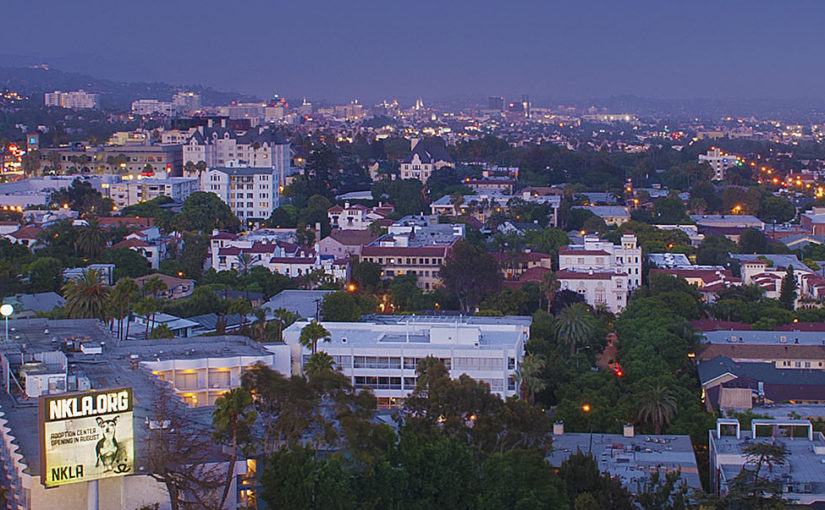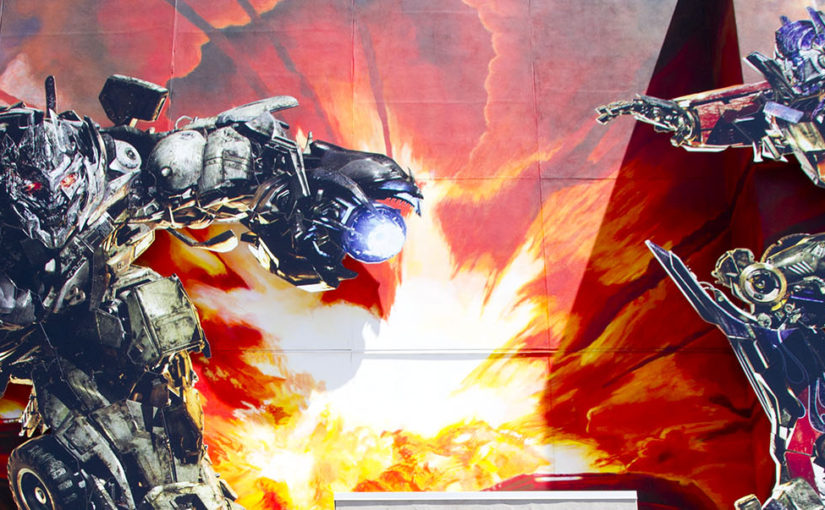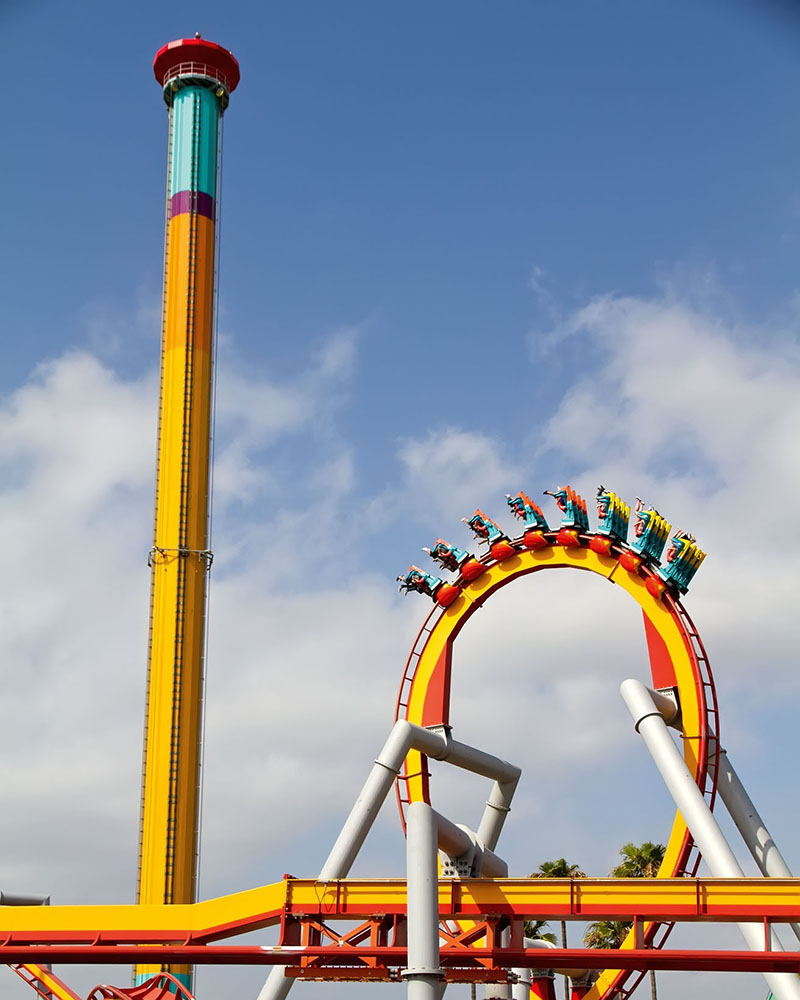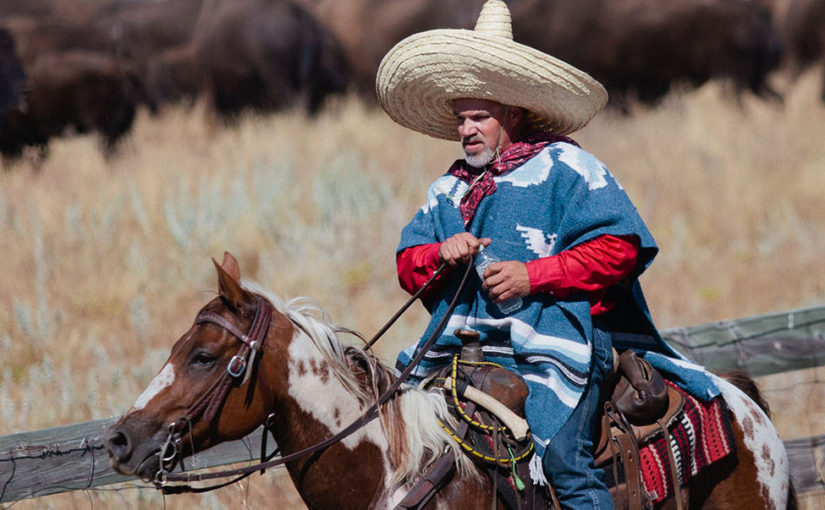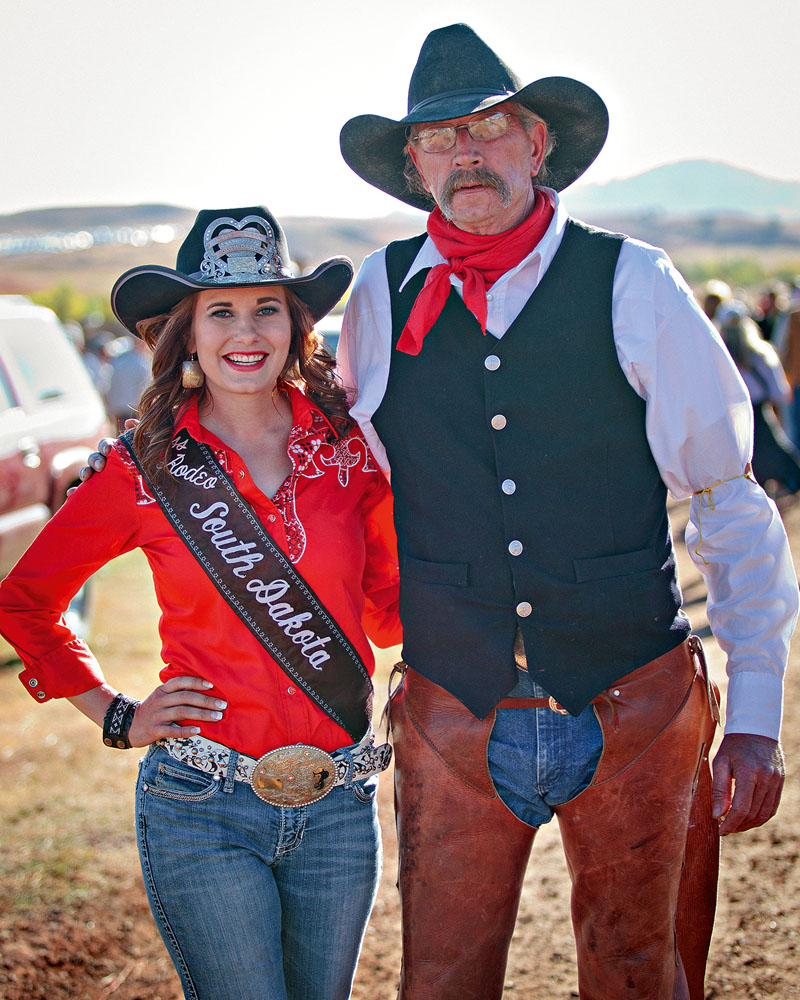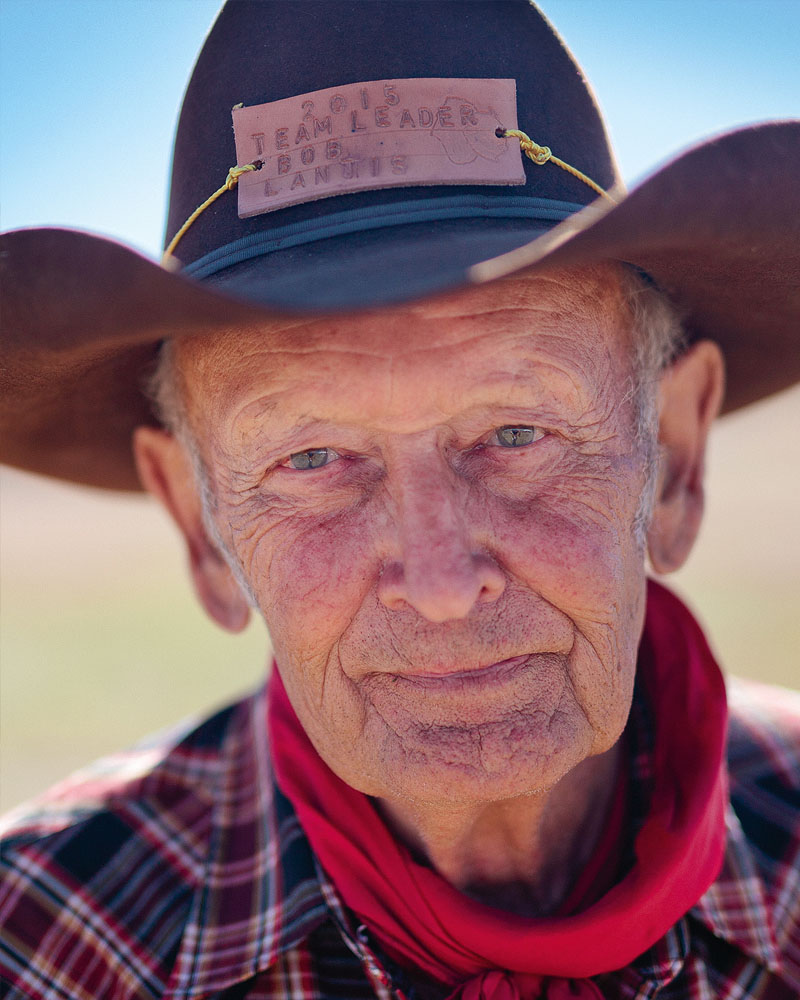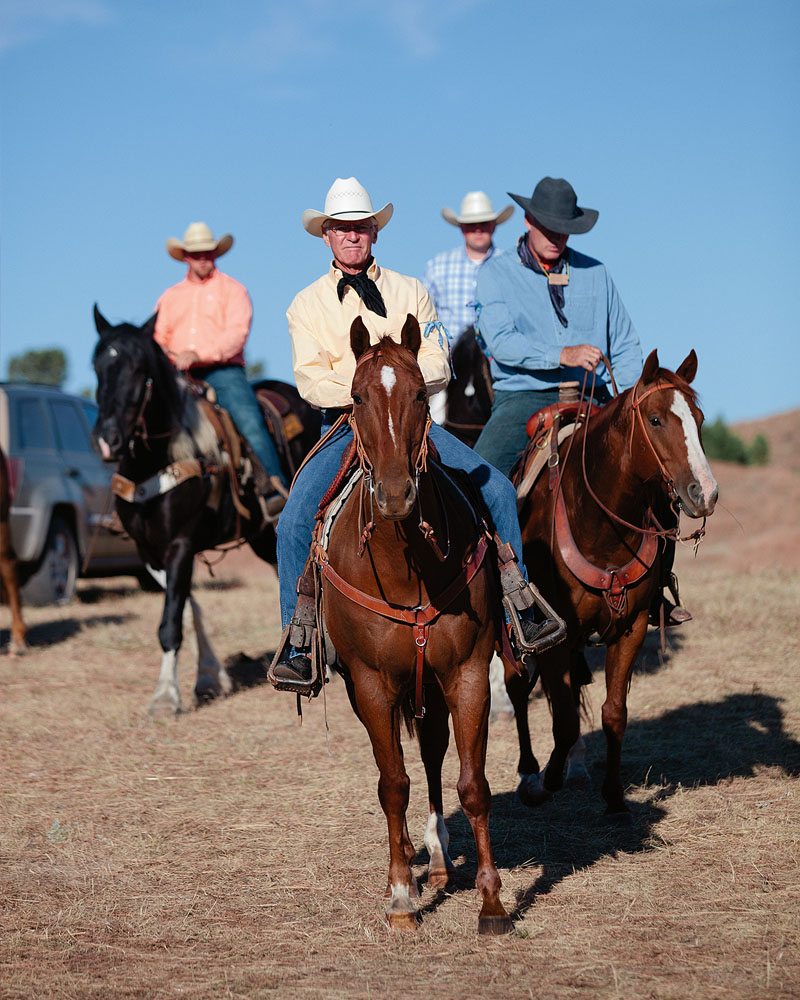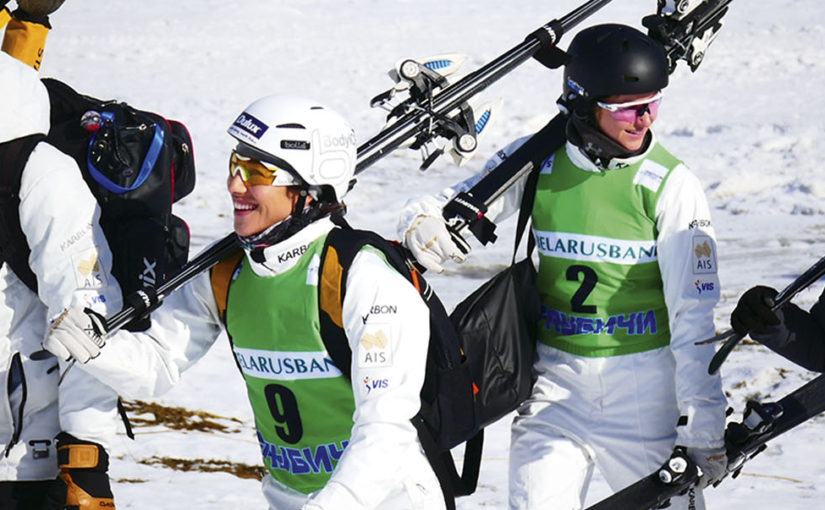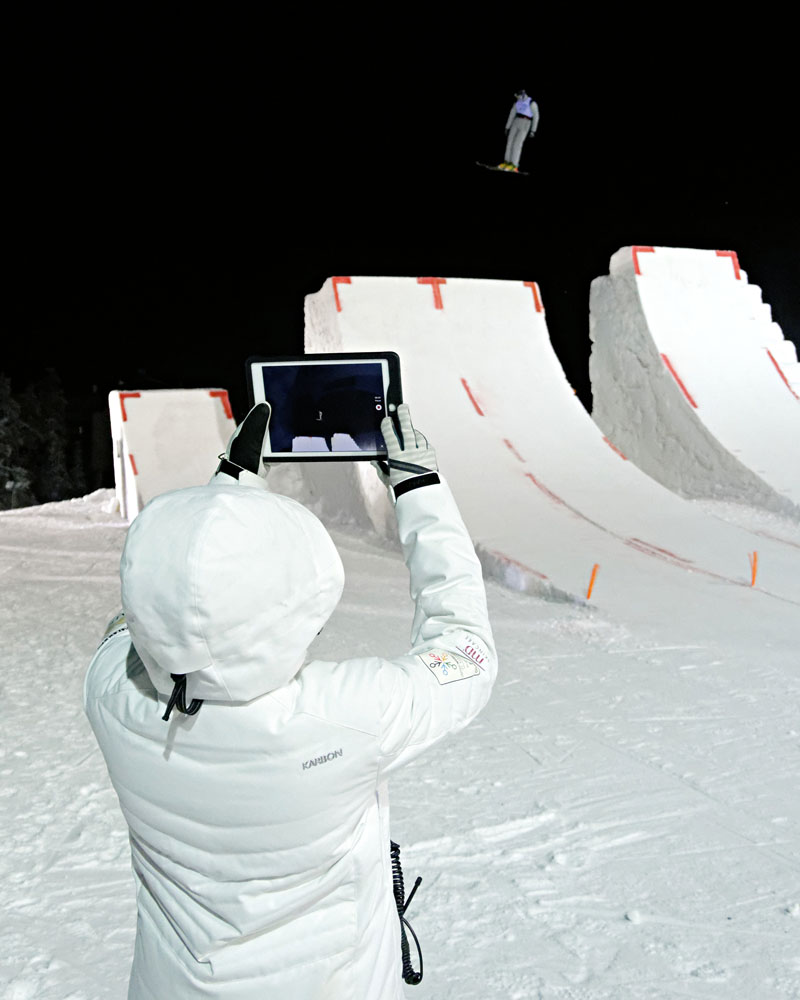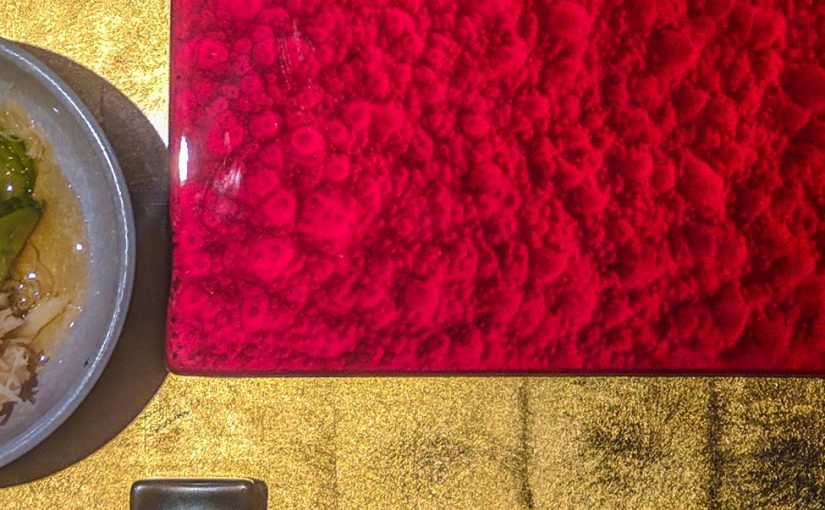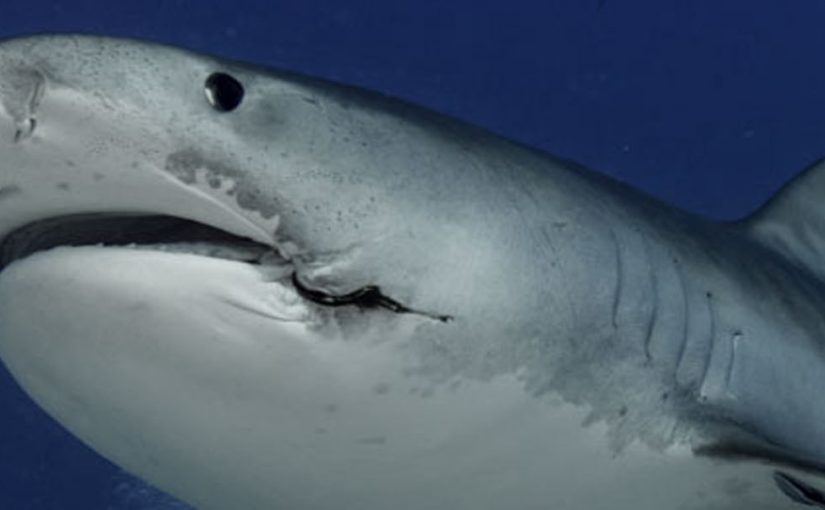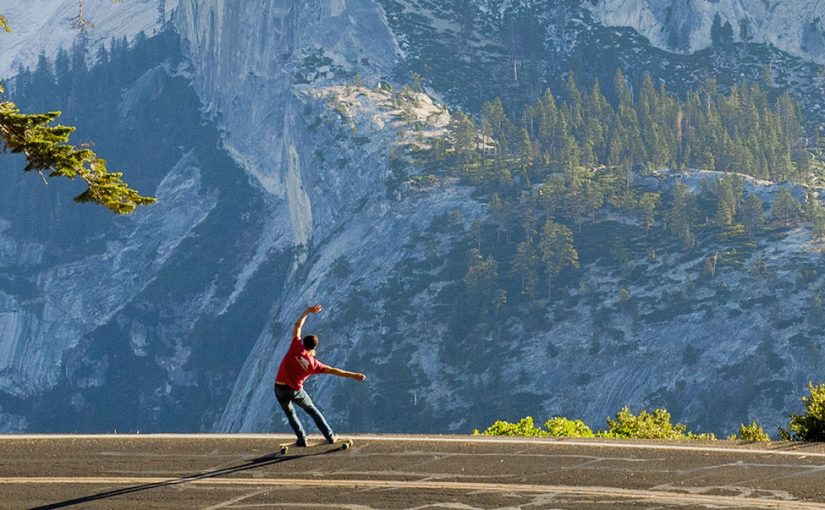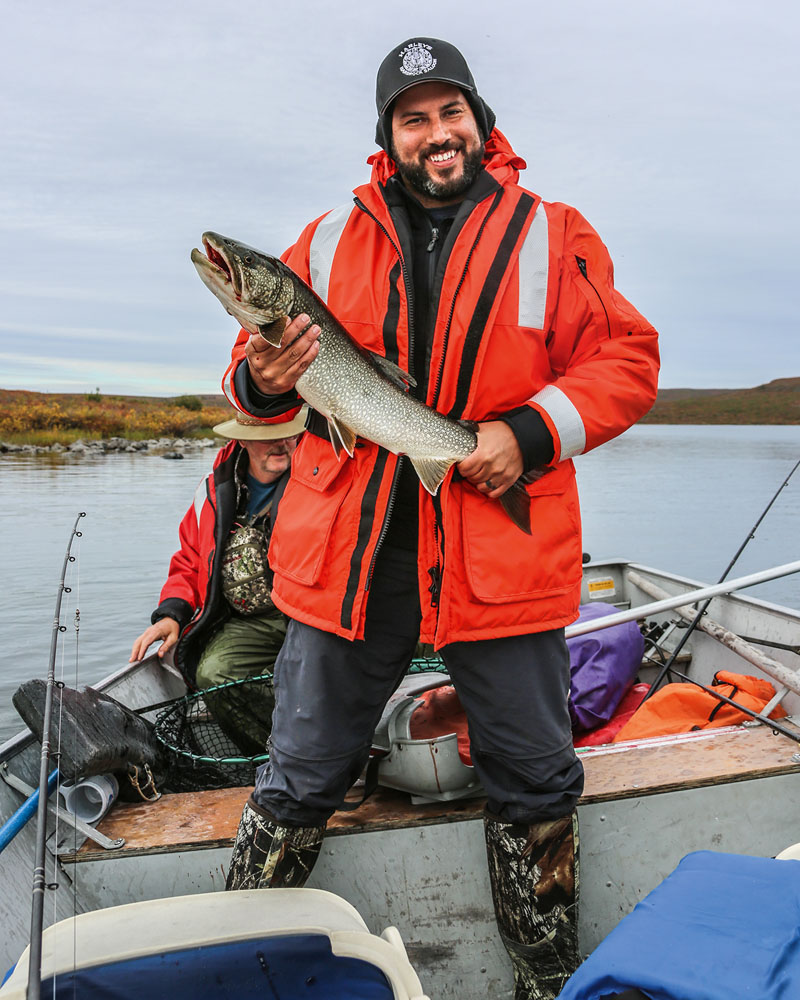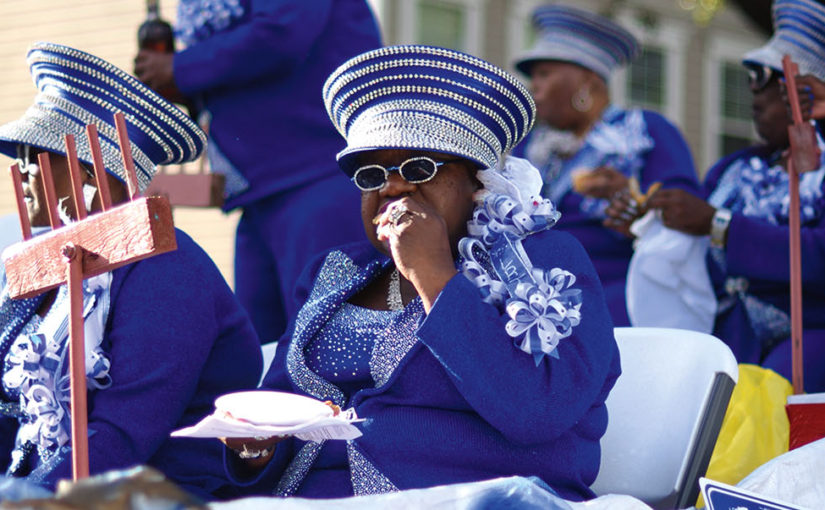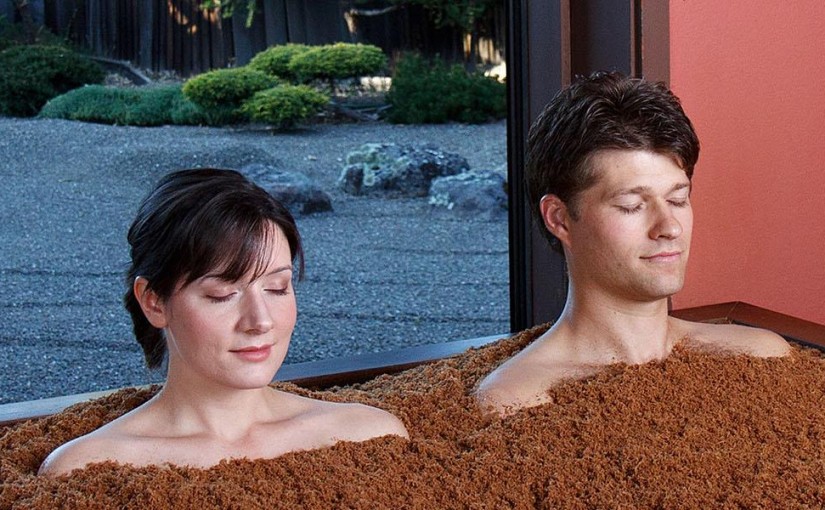West Hollywood is celebrity central, and you could spend the entire time hanging out in the same places as the TMZ paparazzi – Dan Tana’s, the Viper Room, Soho House and Urth Caffé – but there’s another side as well.
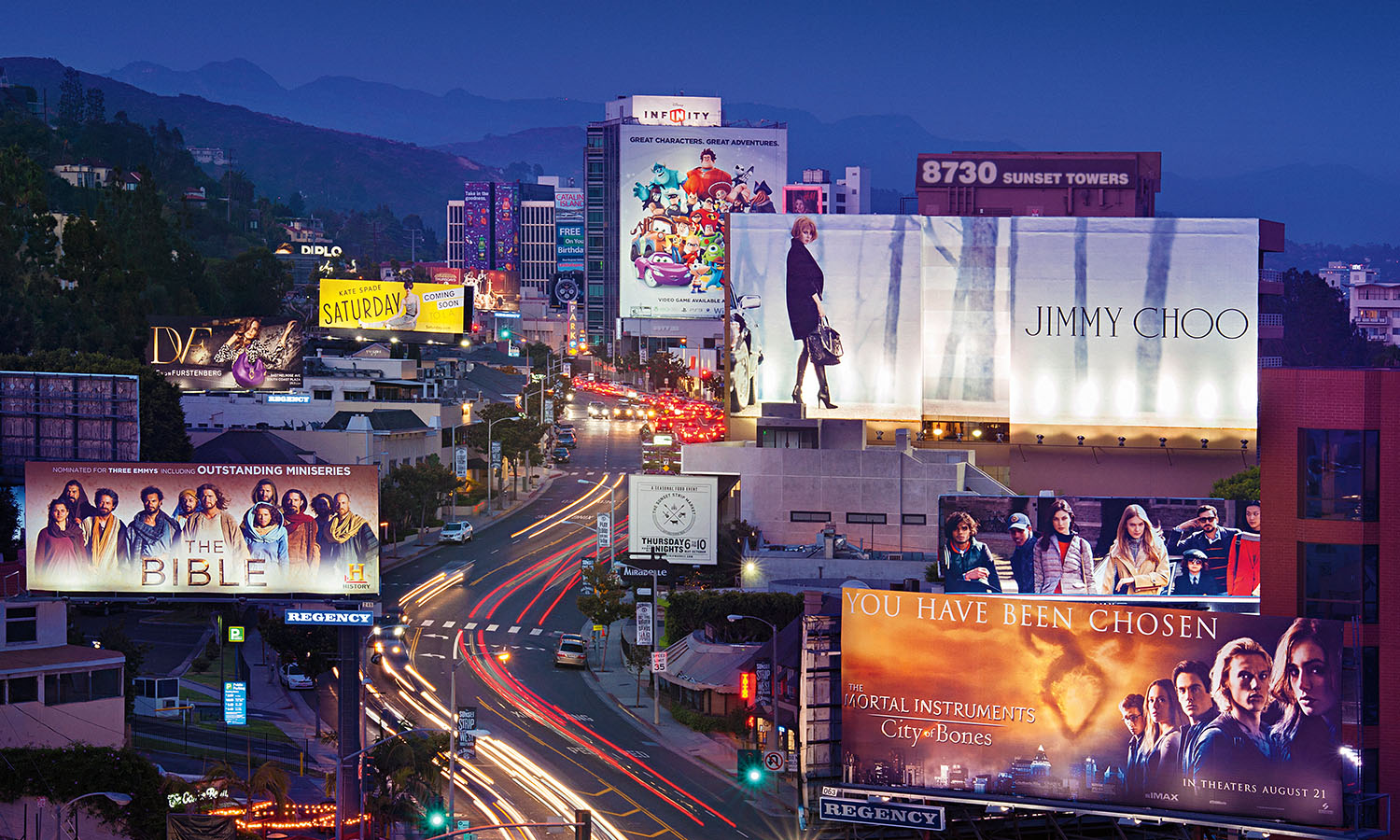

Eat
Are you kidding me?! This is Hollywood. There’s no eating. To survive here you must consume a mere kale juice in the morning, maybe some goji berries later in the day and that is it. However, if you’re not a psycho, LA has some of the best food in the world.
For a little known gem of a place go to Elderberries on Sunset. You could be mistaken for thinking you’d walked into someone’s house. The guys here make everything from scratch right in front of you in the open kitchen, and the food is so fresh they don’t even have a refrigerator. There’s an elderberry juice that isn’t always on the menu, but when it is you need to beat a path to the door – the locals come pouring in to get it and it never lasts long. A small glass of this thick, tart berry elixir will cure you of everything, they say, and I have to admit it got rid of my cold in one hit. Magic.
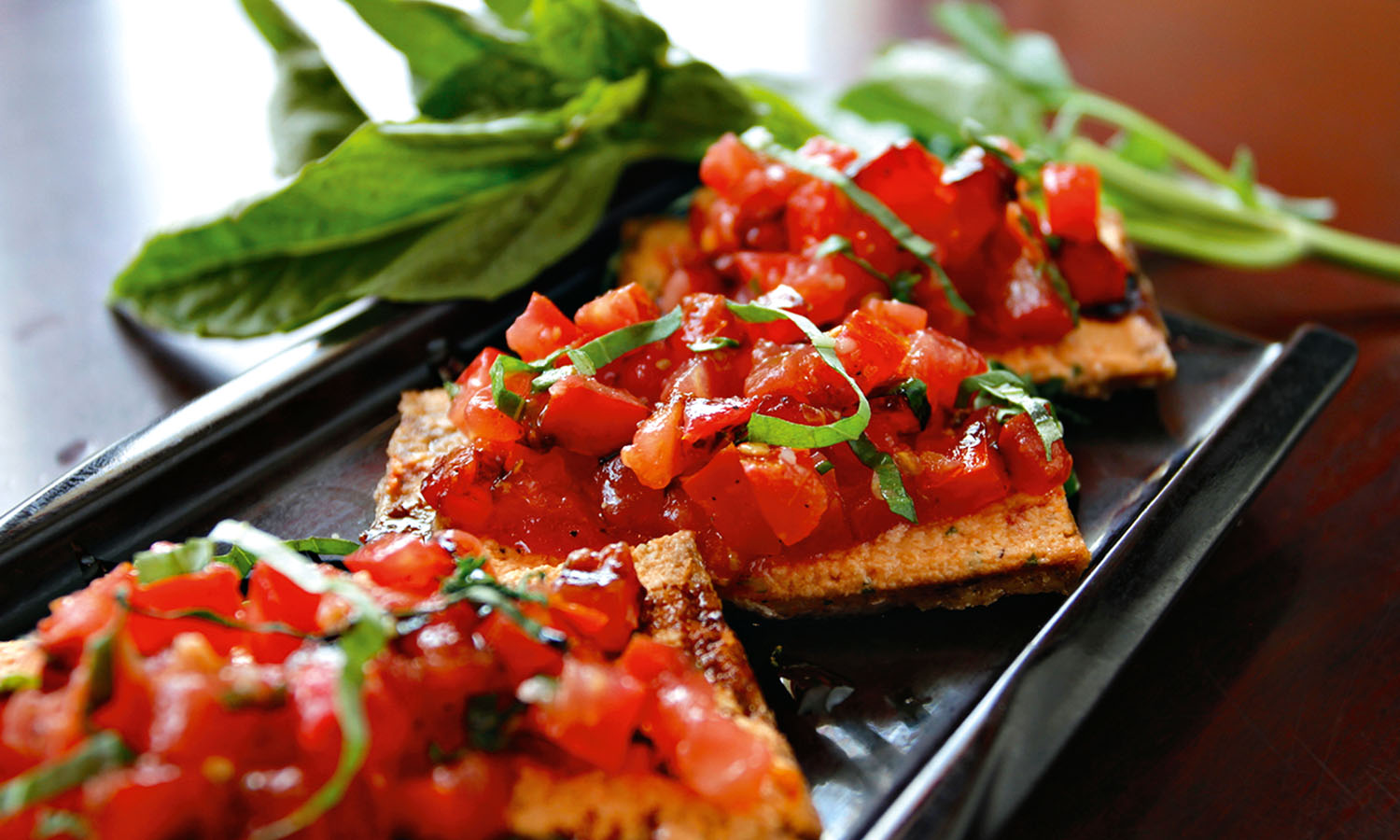

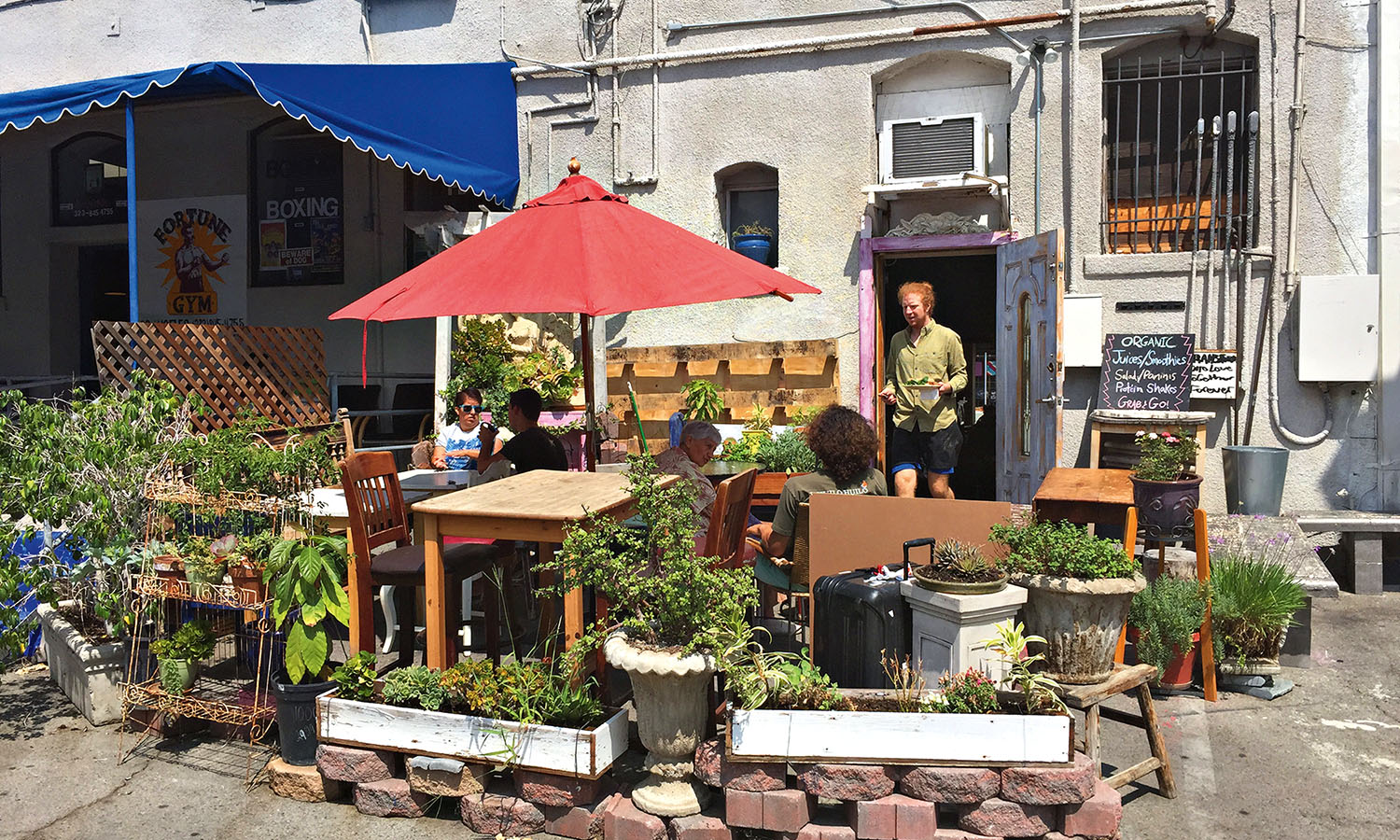

For a real Mexican experience, go to the Gardens of Taxco, just off Santa Monica Boulevard. Now this is a treat. You don’t order, they just bring you what they’re making that night, and there’s always plenty of it. Sit back with a margarita and let the staff make all the decisions for you. While you’re hoeing in, a three-man mariachi band will serenade you. When your mouth isn’t full, sing along – this is a place bursting with atmosphere and you’d be mad not to get involved.
If you want to eat like a true local though, you might have to travel a little bit further (go on, book an Uber) and head to Studio City. That’s where you’ll find SunCafe. This is what LA food is all about: organic, raw, vegan, namaste. If the idea of raw kelp noodles and a macrobiotic bowl seems scary, SunCafe will surprise you. I’ve taken the hardest of carnivores there and they have left the hippiest of tree huggers. The food really is that good.
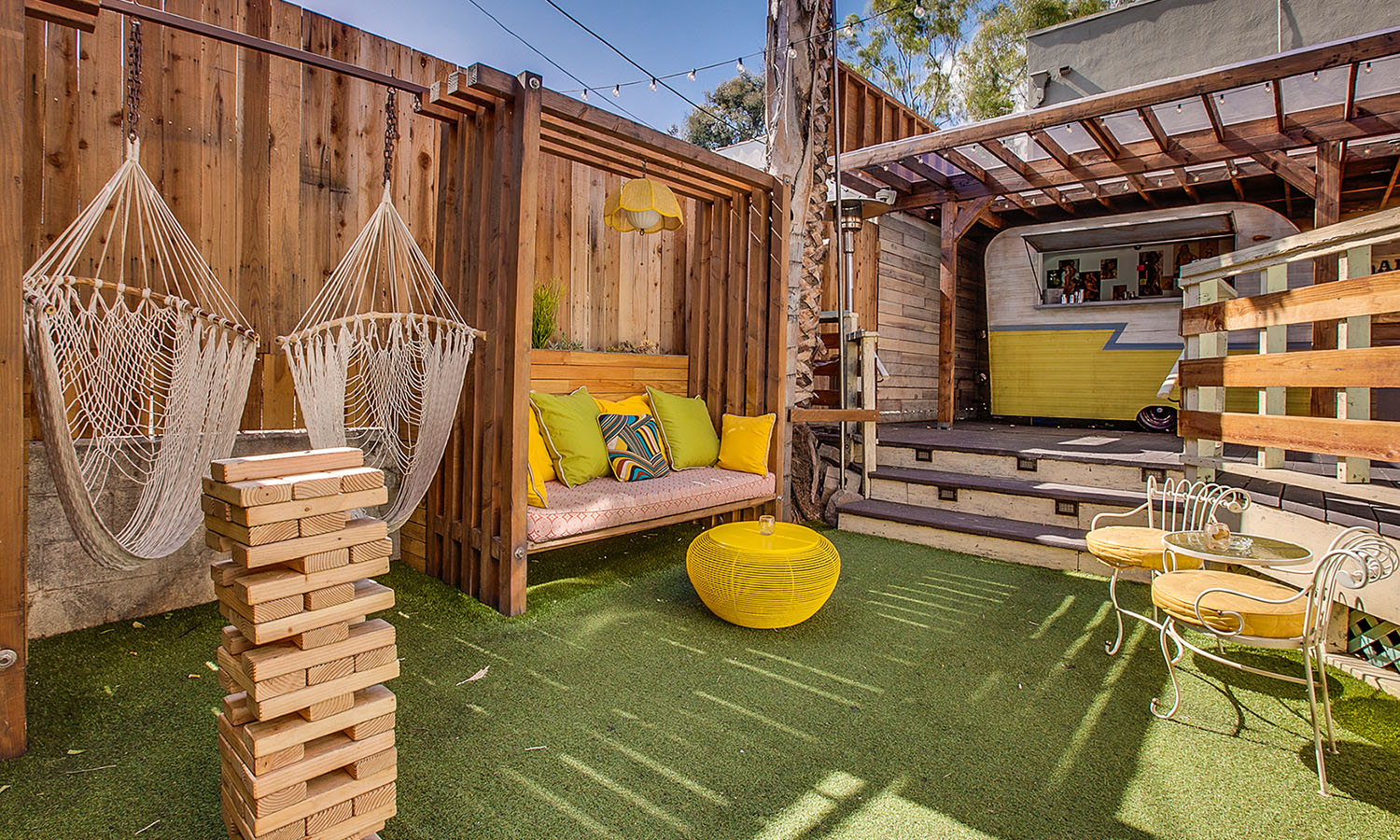

Drink
The thing about Hollywood is that everything and everyone is on show, so to find the behind-the-scenes action you have to be very specific about where you go. To get inside Good Times at Davey Wayne’s, admittedly slightly over the WeHo border in Hollywood proper, you have to walk through a fridge door – and it gets more hilarious from there. Inside it looks as though the entire place has been furnished from a garage sale. For years it’s been a bit of a secret, but people are starting to talk and this quirky, second-hand bar will soon be exploited. Gasp! In Hollywood?! Never.
There are no TVs showing every sport known to (American) mankind here. At The Darkroom, on Melrose, it’s all dim lights and leather jackets. It’s one of those bars that you visit because it makes you feel a lot cooler than you actually are. Order yourself a can of PBR – don’t judge, it’s US$3, huge and a hipster’s delight. I don’t care if you don’t smoke – shut up, get a cigar, sit out the front and pretend you are a gangster. This bar is great.
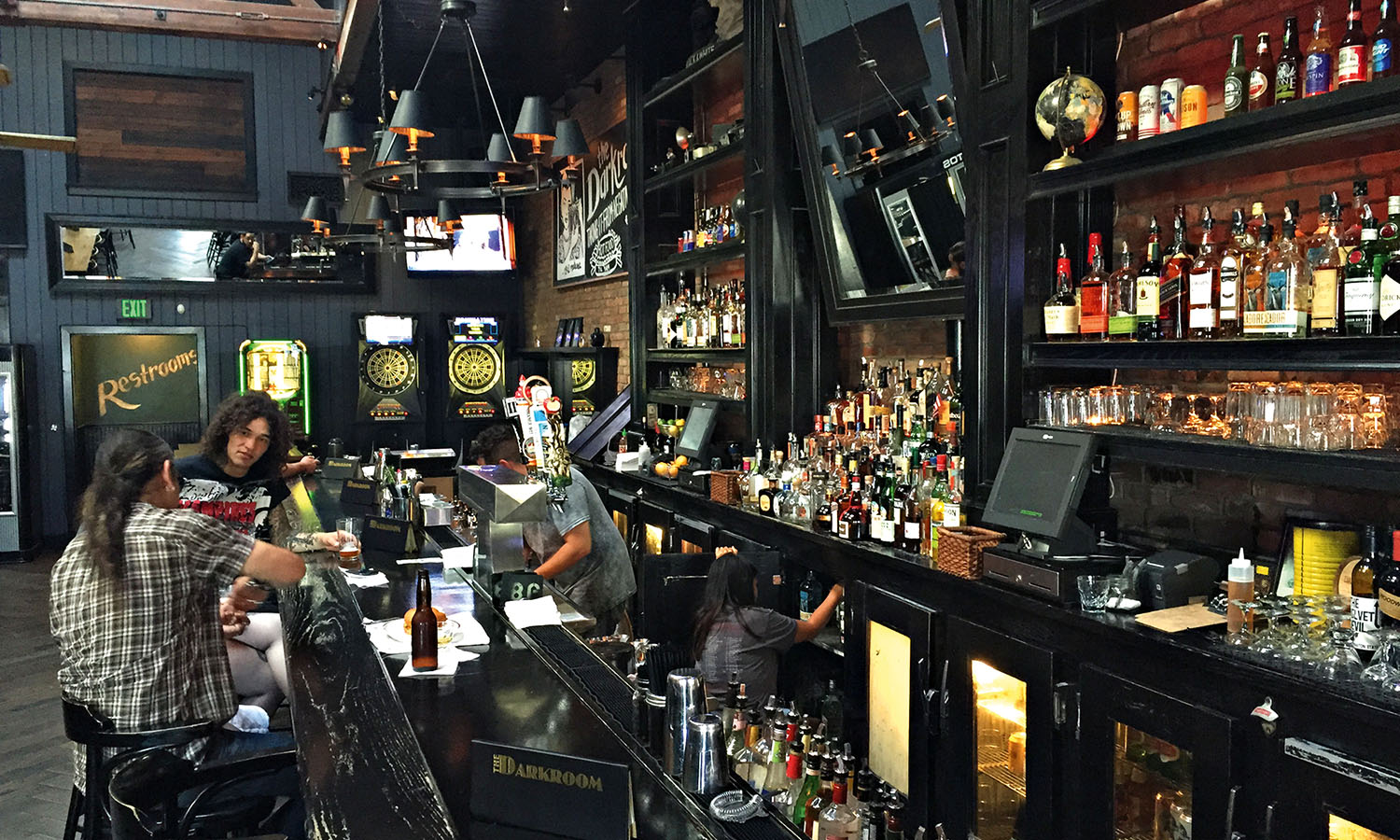

Entertainment
Because this is Hollywood, a trip to the movies seems somehow essential. They’re the reason this place exists. The Sundance Sunset Cinema plays the sort of indie films you’re not likely to see at a suburban megaplex, but are the types of flicks folks in Hollywood make because they’re still passionate about movies. Bonus: on a Tuesday tickets are only US$5.
Hollywood is home to 90 per cent of the world’s best comedians, so heading out to see some stand-up is something you have to do. An obscene number of underground shows are waiting to be found and, more often than not, someone outrageous (and by that I mean famous) will pop in to perform a surprise set. The NerdMelt is a room behind Meltdown Comics on Sunset. It looks like it could be a barn, but they pack in more than a hundred folding chairs and have secret comedy shows. I’ve seen Aziz Ansari and Louis C.K. pop in here, and all without anyone knowing what’s going on. There’s another hidden show called The Goddamn Comedy Jam, held intermittently at the Lyric Theatre on La Brea (keep an eye on the Facebook page for upcoming dates). Basically it works on the premise that every comedian harbours a yearning to be a rock star. This is their outlet. After a short stand-up set, they perform their favourite song with a live band. This is not karaoke – it’s an actual rock performance. Bill Burr, Jim Jefferies and Rob Schneider have all taken to the stage and lived out their fantasies at this amazing show.
If you’ve trawled the internet and street press and somehow not managed to find anything that takes your fancy, do not panic. This is Hollywood and often the best stuff isn’t advertised. You will just be stumbling past some place and see a line outside a door. Join that line – whatever is at the other end of it is probably going to be great. I’ve seen Prince do a random performance at a tiny club, Snoop Dogg at a karaoke bar and talented people doing all sorts of weird crap at small theatres and venues all over the hood. Trust me: join that line.
Like a lot of places, you could spend a year in West Hollywood and keep on finding new and cool things to do. My suggestion is to just go exploring – walk around and you’ll find awesome stuff, from the old vintage stores on Melrose to the tourist explosion that is Hollywood Boulevard. There’s something new around every corner, but be careful after dark – those corners sometimes get a little shady.
Thrill Me, Chill Me…
My heart races as fast as my stomach churns; the wind chills my face as we gather speed. Our Autobot saviour hits the afterburners at the very last second and we shoot forward as missiles come at us from the side. We’re so close that I can feel the heat from one explosion. Megatron fires a fusion cannon. It heads straight towards my forehead and if it were not for some extraordinary evasive action from Evac (the Autobot we’re clinging onto for dear life), I’d be scrap metal. This is like some incredible dream, but it isn’t. It is the latest simulator/roller-coaster amusement park thrill – Transformers: The Ride-3D at Universal Studios Hollywood.
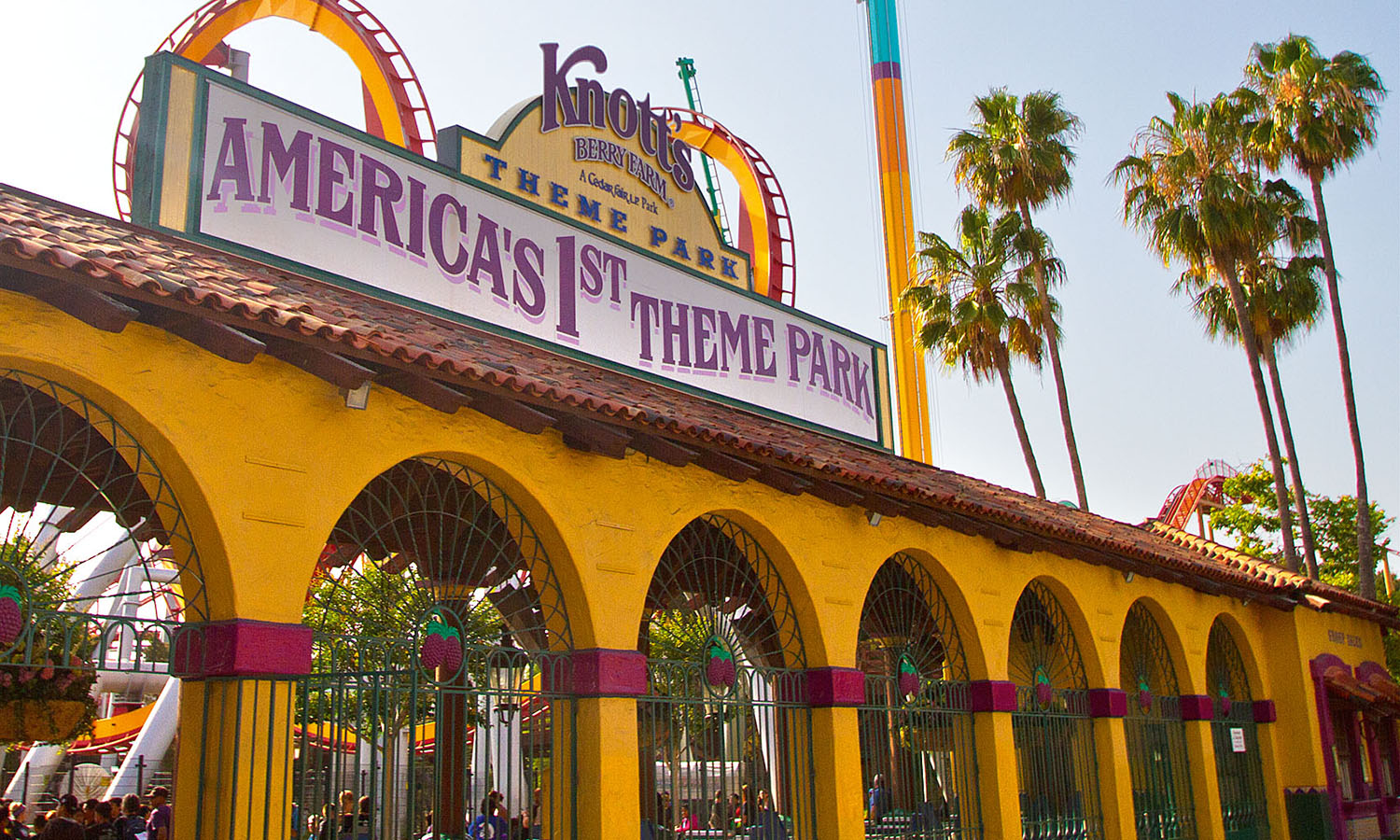

My addiction to thrill rides can be traced back to a holiday in California in 1983. I was 13 and we were visiting Six Flags Magic Mountain, an amusement park that was built not on cartoon characters, but simply on thrills. The Colossus was the source of constant screams. At the time, it was the largest wooden roller-coaster in the world with two drops over 30 metres long and old carts that threatened to derail at any second. It had recently gained notoriety as the roller-coaster that featured in Walley World in Chevy Chase’s comedy National Lampoon’s Vacation. Like the Griswold family, the Jamieson family were enjoying a vacation. We continuously dared each other to ride the Colossus, and when it came time, I was the only Jamieson that did. Perhaps it was this coming-of-age moment, where for once I was braver than dad, which has since attracted me to such rides.
When it comes to amusement parks, California is somewhat of a Mecca. Wide-eyed pilgrims flock to Disneyland, Six Flags Magic Mountain, Universal Studios, SeaWorld and Knott’s Berry Farm, which is the oldest park of them all. Knott’s began life as a berry farm back in 1920. This is where founder Walter Knott created the boysenberry, by crossing a red raspberry with a blackberry and loganberry. But it was Walter’s wife Cordelia who cooked up the Californian thrill-ride storm. Customers at the farm loved Cordelia’s chicken dinners so much that demand grew until thousands of customers were lining up waiting, often for hours, to dine. To entertain the crowds, Walter introduced some rides that were based around a Wild West show.


From these auspicious beginnings, things gathered momentum faster than a Colossus carriage. Knott’s launched the Corkscrew – the world’s first 360-degree roller-coaster – in 1975. This was followed by the Sky Jump in 1976, which was the highest ride in the park until it was overtaken 25 years later by its successor – the 30-storey-high Supreme Scream. In 1978, Montezuma’s Revenge was introduced, a coaster that shoots you to speeds of 90 kilometres per hour within five seconds (and is still there today). Knott’s continued to stay at the forefront of hair-raising roller-coaster rides, while it’s world-renowned neighbour continued to focus on entertaining the kids with Mickey and Minnie.
These days, the advancement of technology means that old roller-coasters like the Corkscrew have been replaced by the Boomerang, a ride with six loops – three facing forward then three facing backwards. It is this ride that, today, almost reintroduces me to the chicken dinner I ate the night before.


I continue to feed my addiction at Knott’s on the Silver Bullet, a rollercoaster that has us hanging in the air, feet dangling as we loop, twist and corkscrew. It suddenly stops and I’m not quite sure if I’m upside down or not. Next up is the GhostRider – currently the longest wooden roller-coaster on the USA’s West Coast. I have flashbacks to the Colossus as we rattle up the first climb and then plummet down a 33-metre drop. It is old and rickety and by the end of it I realise so am I. My neck has a crick and I can barely see the top of the next ride, the Xcelerator, which takes willing passengers from zero to 130 kilometres per hour in just three seconds. People say I am very much like my father and today I agree – I decide to sit the Xcelerator out.
On that family trip back in 1983, we spent one day at Universal Studios. It was enough time to get a Polaroid snapped of ET and I jumping a BMX over the moon. We also took the studio tour and screamed as Jaws creaked out of the lake just as we passed by. ET is long gone these days, though my fear of sharks in fresh water is not.


Transformers: The Ride-3D has replaced the old ET Adventure ride. It cost a reported US$100 million and is at the forefront of fairground attractions. It is designed to suspend all sense of reality (unlike the very real screams coming from the people on the nearby roller-coaster rides).
How does it compare to freefalling 30 stories down in an open outdoor carriage though? Both are thrilling, both are chilling and both are definitely fulfilling, but roller-coasters win for the sheer fear factor. With Six Flags Magic Mountain now boasting 18 roller-coasters, more than any other park in the world, I decide to leave it to my next visit, when I think I’ll bring dad.
Where the Buffalo Roam
I’m in Custer State Park for the fiftieth anniversary of the Buffalo Roundup. The air is thick with dust and excitement, and rent by “hoo-hars!” and whip cracks. Cowhands work in teams to guide the excited bison down a valley, across a road and onto an enormous grassy prairie. Some 15,000 spectators have assembled on the hillside to watch the final surge into the awaiting corrals. All is going well until suddenly it isn’t. I watch the herd disappear into a thicket of trees. When they reappear they are thundering in the opposite direction. The buffalo have turned! The buffalo are doing what they want to do! The buffalo are outta here!
Twice more a rebel bison force breaks away from the main herd and hightails it over a nearby hill causing much consternation. It’s an unexpected and most welcome development. My big fear about the round-up was that it would be a stagey Disney Does Dakota tourist production, but this is very much the real thing. When the last of the wild beasts is steered into the corral there is much applause and more than a few hallelujahs.
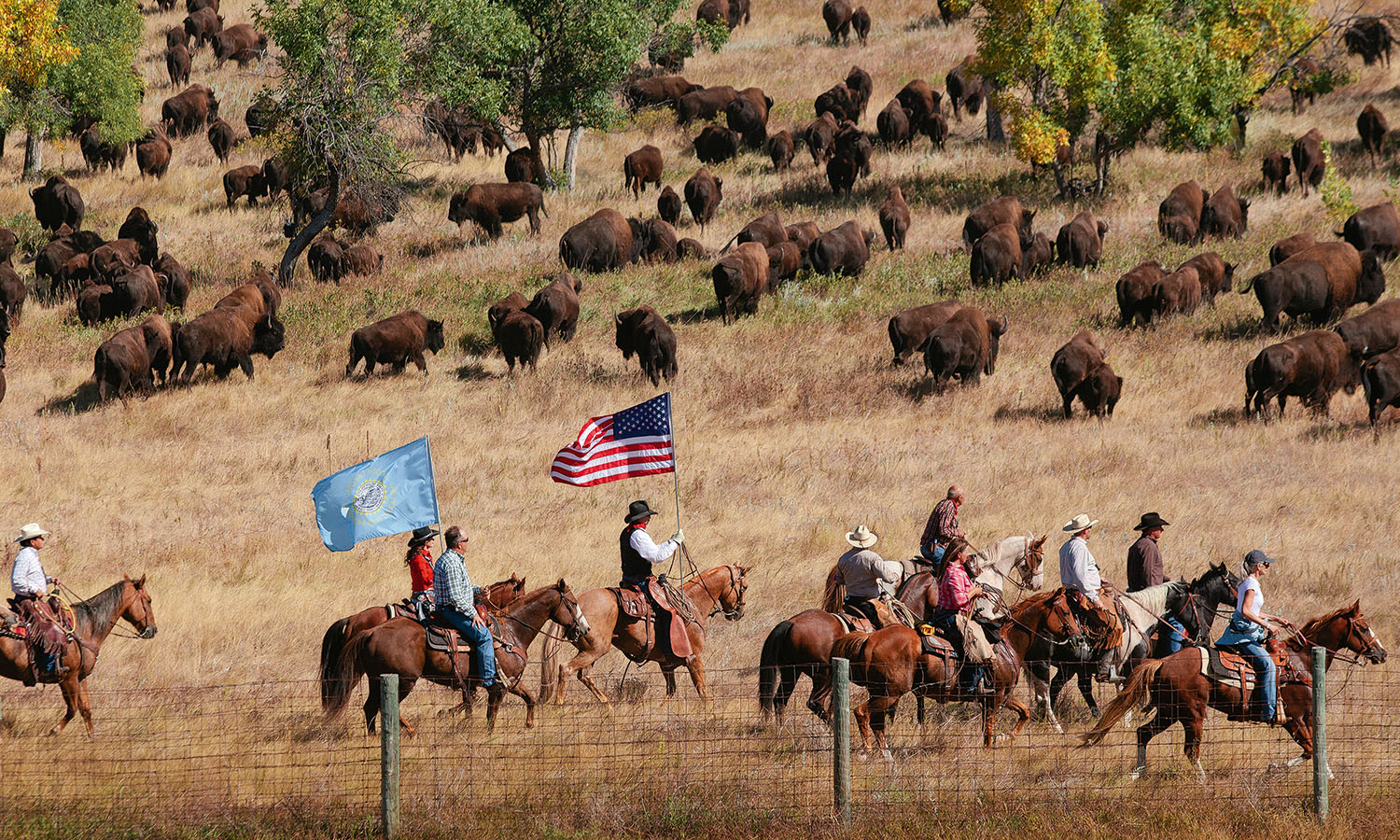

The mighty buffalo are impressive in their own right and are woven into the fabric of the American west. They once roamed the vast interior in the tens of millions and were a crucial part of life for the Plains Indian tribes, providing them with food, clothing and shelter. Then came the European colonisers, with their guns and unshakable ambitions. In 45 years of efficient slaughter they came close to wiping out the buffalo altogether. Conservation efforts saved the species and today one of the biggest wild herds roams free in South Dakota’s Custer State Park. The annual round-up is primarily to maintain the herd size so that they have enough food to last the winter. Tourism is merely an added bonus.
It’s an honour for cowhands to participate. Miss Rodeo South Dakota is here all glammed up in make-up and spurs, holding the state flag atop her gelding Little Man. Horse whisperer and campfire poet Bob Lantis is in the thick of it with all four of his kids. This is the forty-fourth round-up for the 80-year-old. He gets thrown off his horse early and an ambulance is called, but he shrugs off medical assistance and gets back in the saddle. “I’ve been coming here for over 50 years and I’m just so proud that they’ve been able to look after it,” he says. “I keep coming back every year just to make sure they don’t screw it up.” Bob chuckles wryly.
Lantis’s enthusiasm for the Black Hills is widely shared and well founded. Prior to the round-up I spend a week driving around them, climbing up them, spotting wildlife in them and talking to people who revere them as their ancestral land. Pretty in parts, angular and austere in others, the Black Hills are creaky with human drama. They rise modestly from the great plains of central North America but offer disproportionately large insights into America’s pioneering history. While the Wild West has been reduced to myths and bumper-sticker clichés, the real story is nuanced and fascinating. It’s an epic of titanic ambition, monumental achievement, tremendous courage and harrowing tragedy. In its essence it is the story of America.
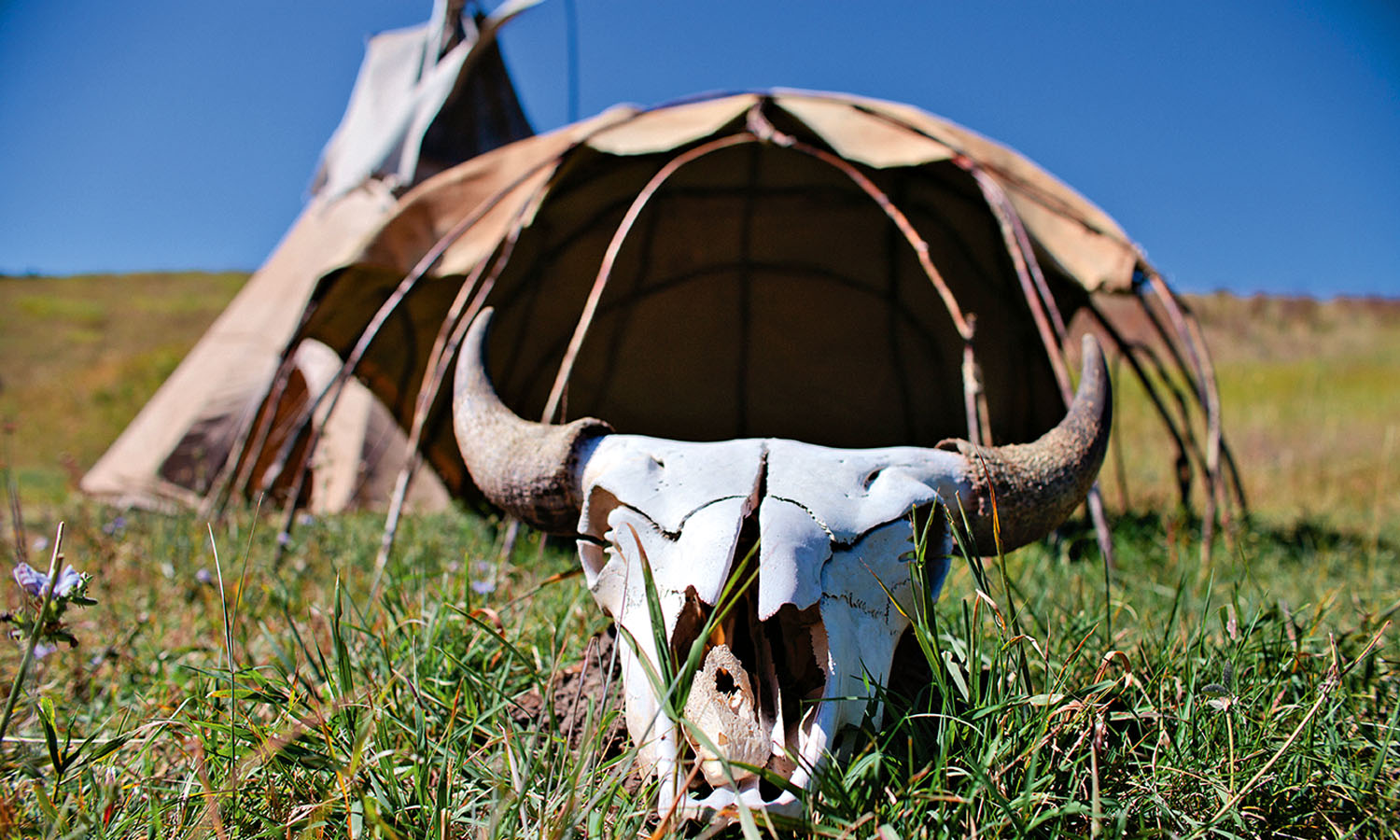

In the gold-mining town of Deadwood I visit the grave of Wild Bill Hickok. Lawman, coach driver, actor, gambler, outlaw and war scout, Hickok wore many out-sized hats. He helped slaves escape north along the underground railway, fought in the country’s bloody civil war, then again in the Indian wars. Along the way he killed at least 10 men and earned a reputation as the fastest gunslinger in the west. Although Wild Bill stories are told six different ways, it’s established he was shot dead while playing cards in a Deadwood saloon, his six shooters tucked into his belt. He’s buried next to Calamity Jane, another Wild West celeb, on her insistence.
Today you can witness Wild Bill’s murder by the coward Jack McCall three times daily during tourist season. Modern-day Deadwood has been burnt down, rebuilt twice and saved by gambling and tourism. I miss the re-enactment of Wild Bill’s slaying in favour of an excursion into a nearby gold mine. It was gold fever that lured devil-may-care opportunists into the Black Hills to form lawless outposts like Deadwood. The cult TV series of the same name has brought to life a handful of the town’s more lively characters, but there were plenty more of that ilk. I’m raising a glass to you, Madam Bulldog, and your establishment, the Bucket of Blood.
Gold fever and the pioneering push came with a cost paid in full by the American Indians. Tatanka: Story of the Bison on Deadwood’s outskirts is a museum sharing the unflinching account of the great buffalo slaughter of the late nineteenth century and its subsequent effects. Plains Indian tribes based their nomadic existence around hunting the shaggy beasts, which they called tatanka and considered a relative. Europeans slaughtered the buffalo en masse for their hides, but also to drive the remaining Indians on to reservations where the exchange rate was one glass of whiskey per buffalo hide. You can imagine how that ended.
That noted, there remains a great deal of pride in Native American culture. Its art and philosophy, respect for the natural world, eloquent orators and history of resistance are all widely celebrated. During the Black Hills War of 1876, Lakota and Cheyenne Indians defeated a bigger and more heavily armed US army in open combat including, most famously, at the Battle of Little Big Horn. One of the most revered warrior leaders of that campaign was a quietly spoken Lakota thunder-dreamer whose presence today can still be witnessed in the mountains. His name? Crazy Horse.
Crazy Horse literally looms out of the Black Hills, west of Mount Rushmore, in the form of a memorial sculpture taking up an entire mountain face. It has been under construction for 67 years and, on completion, will be the biggest on earth, standing 172 metres tall and 195 metres wide. The completed head of Crazy Horse alone is already bigger than any of the Rushmore presidents. The story of its construction is equally gargantuan. It was started by Polish sculptor Korczak Ziolkowski, who chipped away at it by himself with a chisel and a shed-load of dynamite. When he passed, his 10 children inherited the project. A third generation of Ziolkowskis is now onsite and it’s debatable whether any of them will live to see the sculpture’s completion.
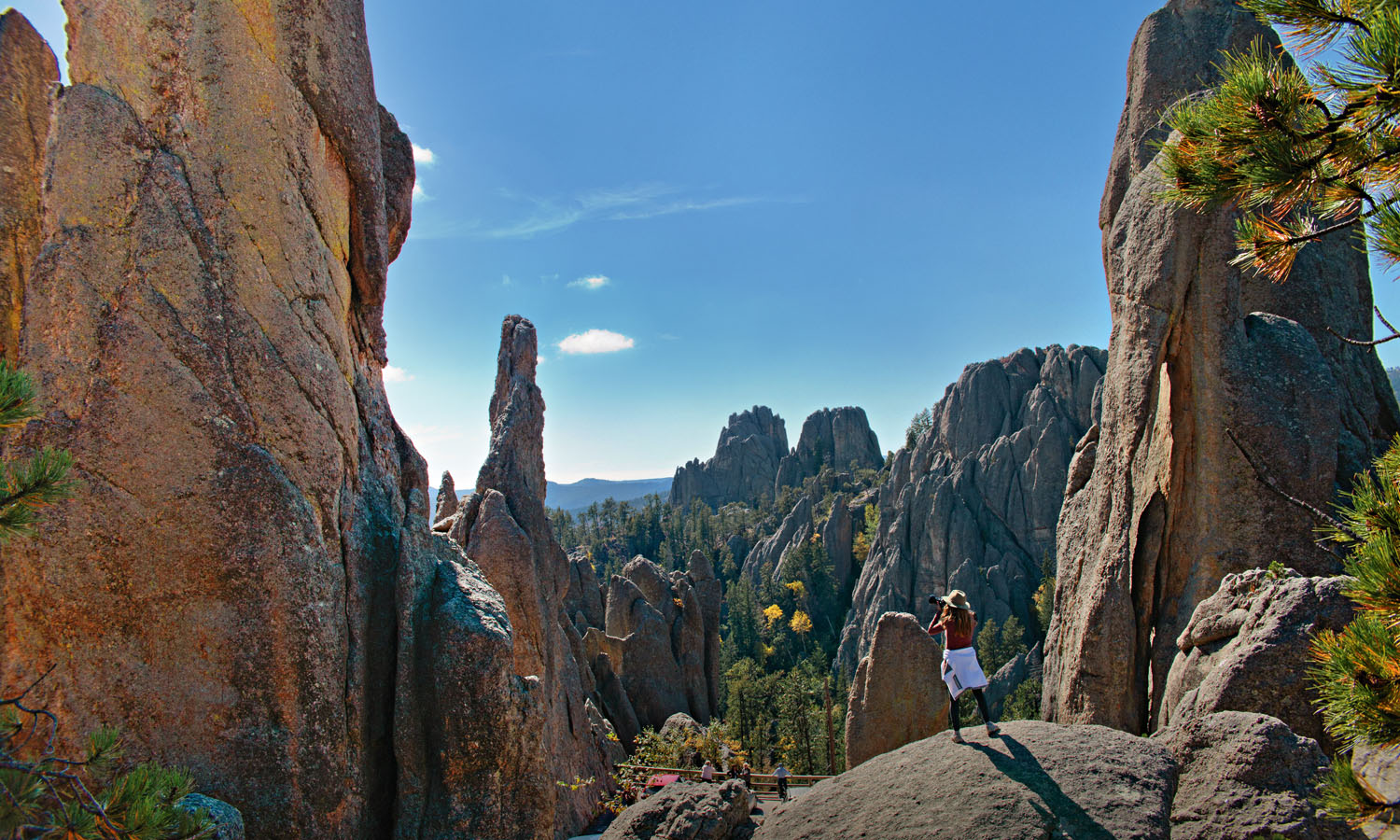

While some Indians support the Crazy Horse Memorial, others consider it a desecration. The Black Hills are sacred for Lakota, nowhere more so than at its tallest point, Harney Peak, which I set out to hike on a clear autumn day. The pine forest is gilded in patches of gold and I spot a whitetail deer and a scurry of chipmunks gathering nuts like acquisitive, more authentically follicled Donald Trumps. A heavy mist cloaking the valley burns off when we reach the summit and the view opens into a stunning panorama stretching to the distant Rocky Mountains. “It’s an easy day to be grateful,” comments a beaming local hiker, capturing the summit mood.
South Dakota is not short of surprises. Best known for the presidential heads carved into the mountain at Mount Rushmore, its other attractions are unfamiliar even to most Americans. It has an ancient inland sea – now a maze of layered, fossil-rich chasms – known as the Badlands. It has the biggest motorcycle rally in the world that incorporates two weeks, each August, of leather, burn-outs and hair metal and doubles the state’s population. There’s fly-fishing in Spearfish Canyon, rock-climbing in the aptly named Needles, Indian history to discover, horse riding at Ghost Canyon Dude Ranch and, of course, the Buffalo Roundup, which rates high among the many highlights of my trip.
I leave invigorated and laden with treasure: Lakota arrow heads, Deadwood playing cards, lucky charms and a hunting hat that proudly proclaims South Dakota as Big Cock Country. My camera’s memory cards are full of big prairie landscapes and wide, open American faces. My notepads overflow and my nose is buried in a Crazy Horse biography. It’s a good sign when an unfamiliar place follows you home. And it’s a nice bonus to have a swaggering sentence to hand when you’re asked what you got up to in the States. Rounding up wild buffalo in South Dakota sounds better than a lost weekend in Vegas, and it’s definitely more memorable.
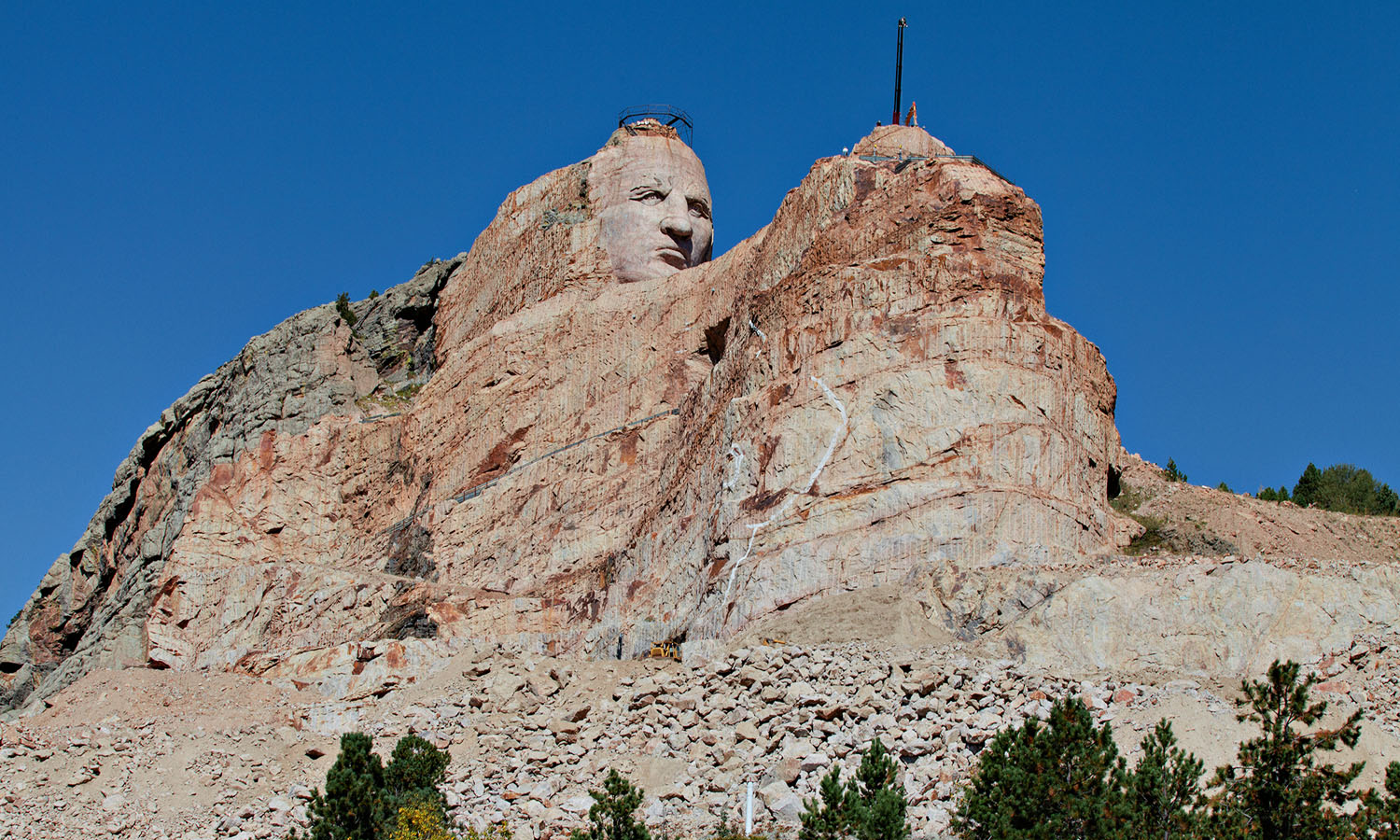

Game On
“I chickened out at the last minute,” the 32-year-old tells me from the Australian Aerial Ski Team’s summer training ground. “I gained a new respect for the athletes – who perform multiple flips and twists on every jump – after that.”
Such is a typical day in the office for the team’s dedicated physiotherapist, who is gearing up to travel to the 2018 PyeongChang Winter Olympics with the aerials team when we speak.
“It’s crazy to think that the last time I experienced the Winter Olympics was as a seasonaire,” she says.
She’s referring to Vancouver 2010, when we met as keen skiers who had both put our careers on hold to ‘do a season’ in Whistler, which hosted the Winter Games’ alpine and sliding events. Having long-harboured a dream of becoming a physio for the Australian cricket team, Jessie shifted her focus that winter.
“By the end of the season, finding a way to combine my love for skiing, physio and travel had become my new goal,” she says. “I mean, I don’t even play cricket.”
Back home in Melbourne, a chance conversation with one of her patients who had a contact at the Olympic Winter Institute Australia (OWIA) provided the perfect ‘in’.
“It was one of those right-place-right-time scenarios, as the OWIA was in the early stages of developing a network of physiotherapists back then,” Jessie says. “The institute now offers a range of professional development opportunities for physios interested in winter sport, which is great for people looking to get their foot in the door.”
Following a stint with the snowboard half pipe team, Jessie joined the aerials staff in 2014 and has been travelling with the team for up to nine months each year ever since. Following summers in Park City, Jessie’s ‘aerials family’ hit the winter competition circuit, zipping between venues from Finland to Korea, Belarus to Spain. With the team constantly on the move, Jessie treats athletes wherever she can, “In hotel rooms, airport lounges, or wherever there’s free space!” she laughs.
On top of attending to the team’s physio needs, a typical work day sees Jessie supervise strength sessions in the gym and hang out at the base of ski jumps to provide medical aid as needed during training sessions and competition events. And there’s no slacking off slopeside.
“It’s also my job to film the athletes’ jumps and help out with hill preparation,” Jessie says. Days can be long and they are always spent in the elements, toughing the snow or sun.
“Boot heaters are one of the best investments I’ve ever made. Standing on snow for eight to ten hours on a competition day is just brutal.” The payoff, however, is sweet.
“Seeing the athletes succeed – especially when the odds aren’t in their favour – is always special,” Jessie says. “In the days leading up to the 2015 World Championships, for example, Laura Peel was struck down by food poisoning, and she came out and won the competition. The athletes’ ability to clear their mind and focus on the task ahead never fails to impress me.”
Having grown up in Albury, New South Wales, just 90 minutes’ drive from Falls Creek, Jessie has been skiing herself since she was a toddler, though most people are surprised to learn that she doesn’t get as much hill time as she’d like these days.
“With other snow disciplines, physios need to be able to ski to the site and alongside the course, but aerial jump sites are all walkable from the base of the mountain, so I don’t really get to ski on the job – on snow, at least,” she rues.
However, Jessie admits the long periods away from home is a bigger downside.
“I’ve missed a lot of significant events, including my grandfather’s funeral, which broke my heart,” she says. “Moving around all the time also makes it incredibly difficult to maintain personal relationships.”
Luckily, her next gig – at the Commonwealth Games on the Gold Coast – will allow her to put her skillset to use closer to home.
“I’m going to be working as a volunteer physio at the Athlete’s Village, treating any type of athlete who requires assistance, which will be a nice change of scenery,” she says. “As much as I love the snow, it’ll be great to work near the beach for once.”
Secret Sushi
You hear whispers of this secret sushi restaurant online and with friends. Someone says they know someone who knows someone who has been, but you think this is just another urban legend, like when Bill Murray spontaneously walked into a random bar and started bartending.
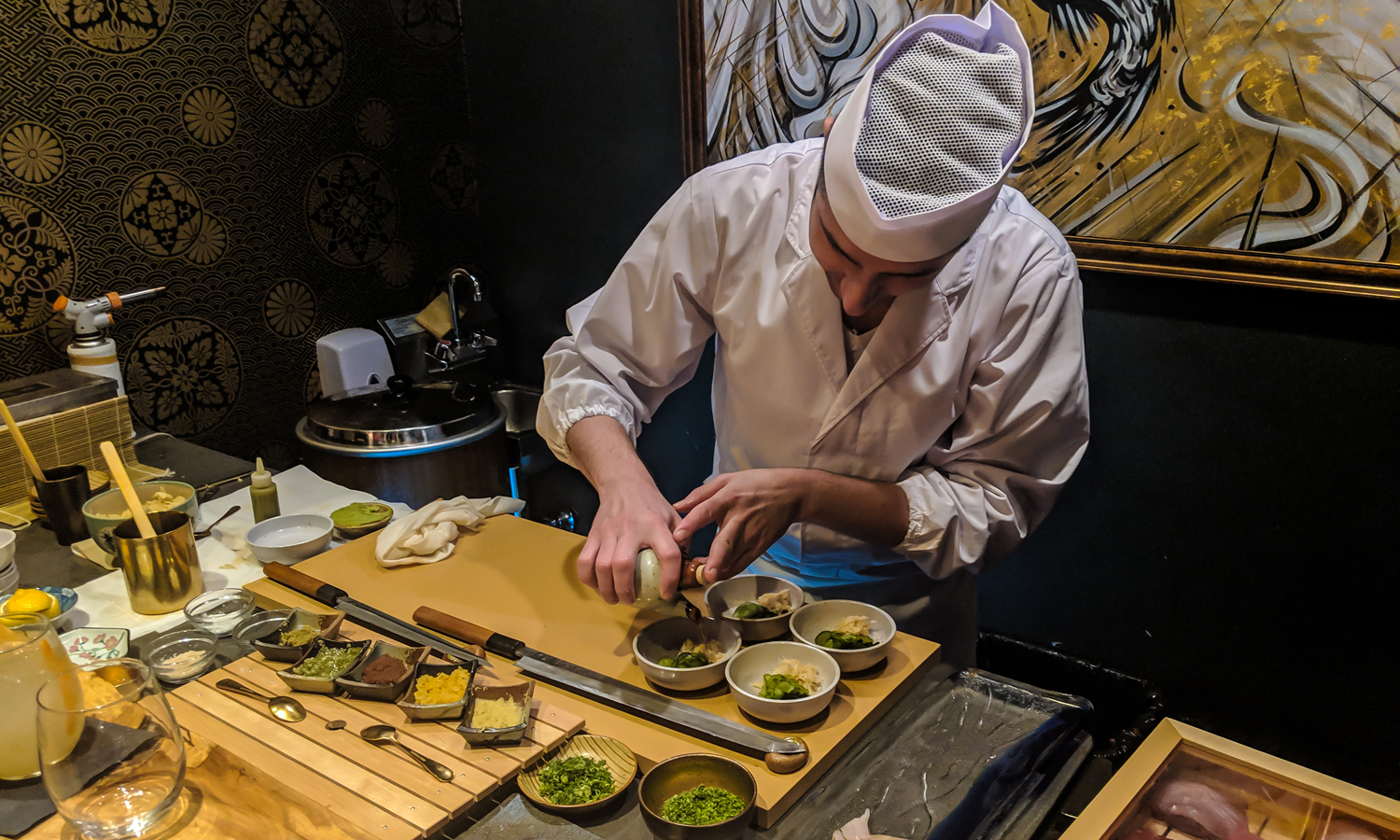

Well, it turns out that like the Bill Murray story, the restaurant actually exists. On the tenth floor of a very random midtown Manhattan hotel you will find one of the rooms has been converted into a full scale, fine dining, four-seat sushi restaurant. Global personality Chef David Bouhadana is the master itame at the helm of this 17-course, 60-minute omakase (dishes selected by the chef).
If you can get in, expect a treat. Chef David will let you know everything about him and his process, and will do so over a flowing river of sake. The food is perfectly prepared and the city views from the balcony are sublime.
This is an experience not to be forgotten. Ever. Even if your friends don’t believe you went.
Take pictures, you will need them for proof.
Tiger shark diving
When it comes to sharks, tigers are one of the most thrilling species to see. At Tiger Beach in the Bahamas you can come face to face with these magnificent creatures, sans cage, for an experience like no other.
Get acquainted with the entire ‘shiver’ of sharks with guru Gregory Sweeney. Greg’s been running shark trips here for over ten years and knows these guys well, ensuring you can relax enough to enjoy the excitement of every encounter, while he’s also a big fan of Australian and Kiwi travellers.
Tiger Beach & Bimini Island Shark Diving Guest Experience from Gregory Sweeney on Vimeo.
Trips operate from the MV Dolphin Dream, an 26-metre expedition yacht. An intimate group of ten divers plus crew means you’ll get maximum personal time with the sharks as well as fantastic photo opportunities. Greg is an accomplished underwater photographer and expeditions tend to attract photographers from around the world, so if you want to pick up some tips from the experts this is the place to do it.
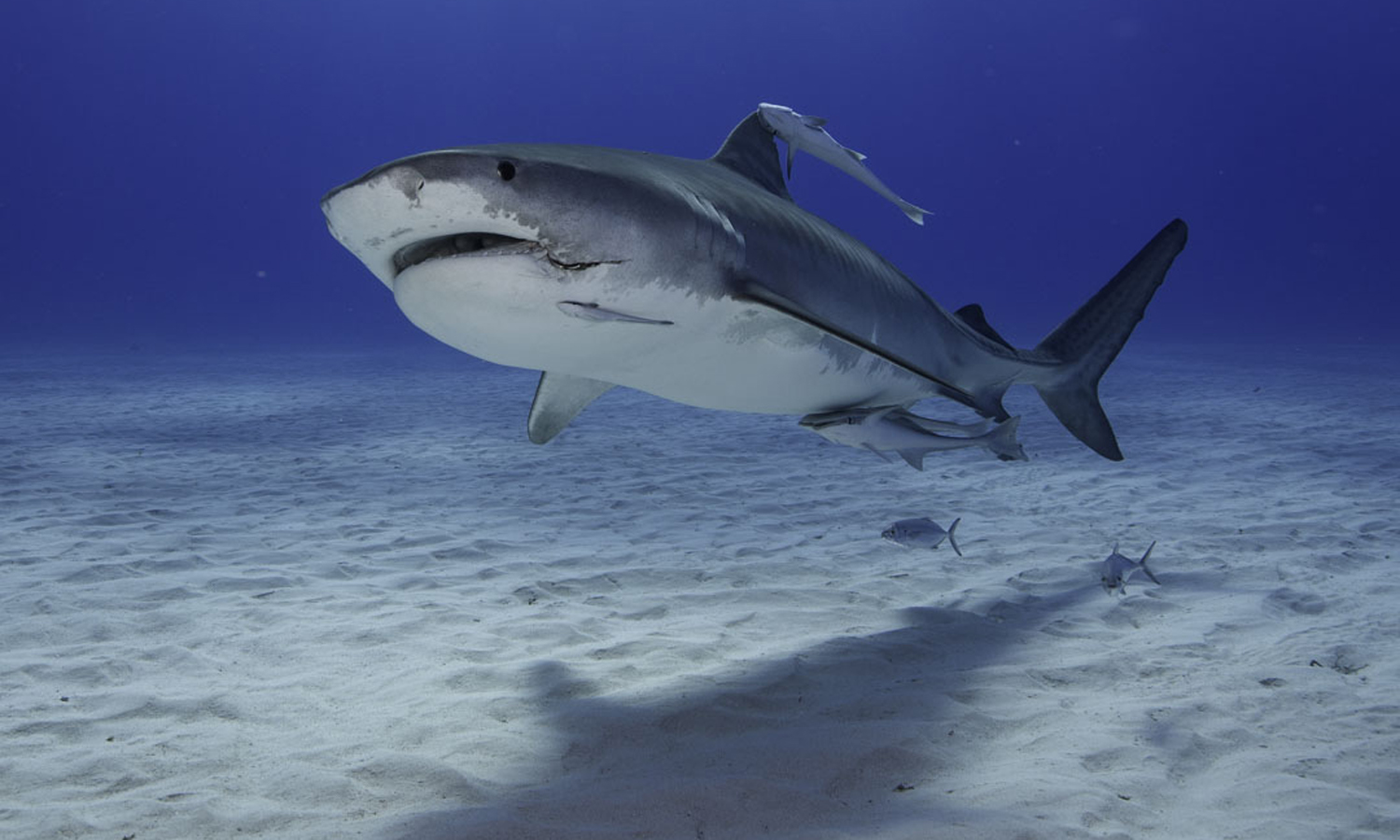

Tiger Beach trips run in October when tiger sharks gather in large numbers for breeding, but an alternative in March combines both tigers and hammerheads for the ultimate experience. You’ll also see other predators like the lemon shark and graceful Caribbean reef shark.
This is a truly unique opportunity to witness these rare and majestic creatures while also understanding and appreciating their vital role in our oceans.
Shaping The Landscape
Obviously on a short holiday you don’t always have the time to revisit a location on multiple occasions, so here are a few tips to help you get a better shot. Because it’s happened to all of us. That moment when we’ve stood in front of an epic view, looking out at it with a sense of awe, and finding when we get back that our photos don’t do it justice.


The Golden Hour
Nothing beats the light of the rising or setting sun. Every landscape looks better during the golden hour – that time when the sun casts a beautiful yellow-orange light on the earth. If you can, and you should, get up early and get to your photo location an hour before sunrise. Why pick sunrise over sunset? Because the best landscape shots often happen at places – lookouts, waterfalls, beaches – popular with lots of tourists. If you can beat the crowds, do it!
You won’t just get an amazing location to yourself, you’ll actually be able to enjoy the place much more knowing you’re seeing it as few other people do and, by the time the unknowing crowds arrive, you can leave with a big smile on your face.
Obviously this requires a bit of research and some planning. A good landscape shot reflects this. At what time and where does the sun rise? How can you use that to come up with the best composition? Think about your location, do some research and work out what image you want to get before you get there, so you don’t waste precious shooting time phaffing around trying to work out the best angle to avoid the inconveniently located car park.
All About Scale
Landscapes are all about showing the big picture. By using an ultra-wide lens, like the Olympus M.Zuiko 7–14mm f/2.8 Pro, you’ll capture the widest possible angle of your scene. The additional advantage of a wide lens is that it usually stretches the edges of your image and creates leading lines – the ones that pull the viewer’s attention toward the centre of an image – into the scene.
If, for example, you’re shooting a big valley or mountain, try framing your shot with familiar-sized objects in the foreground to create depth. This will give the viewer an idea of how vast the forest, tall the mountain or deep the valley actually is when they see it off in the distance.
To create an even stronger sense of depth and scale get down low or point your camera down a little and add a foreground into your image.
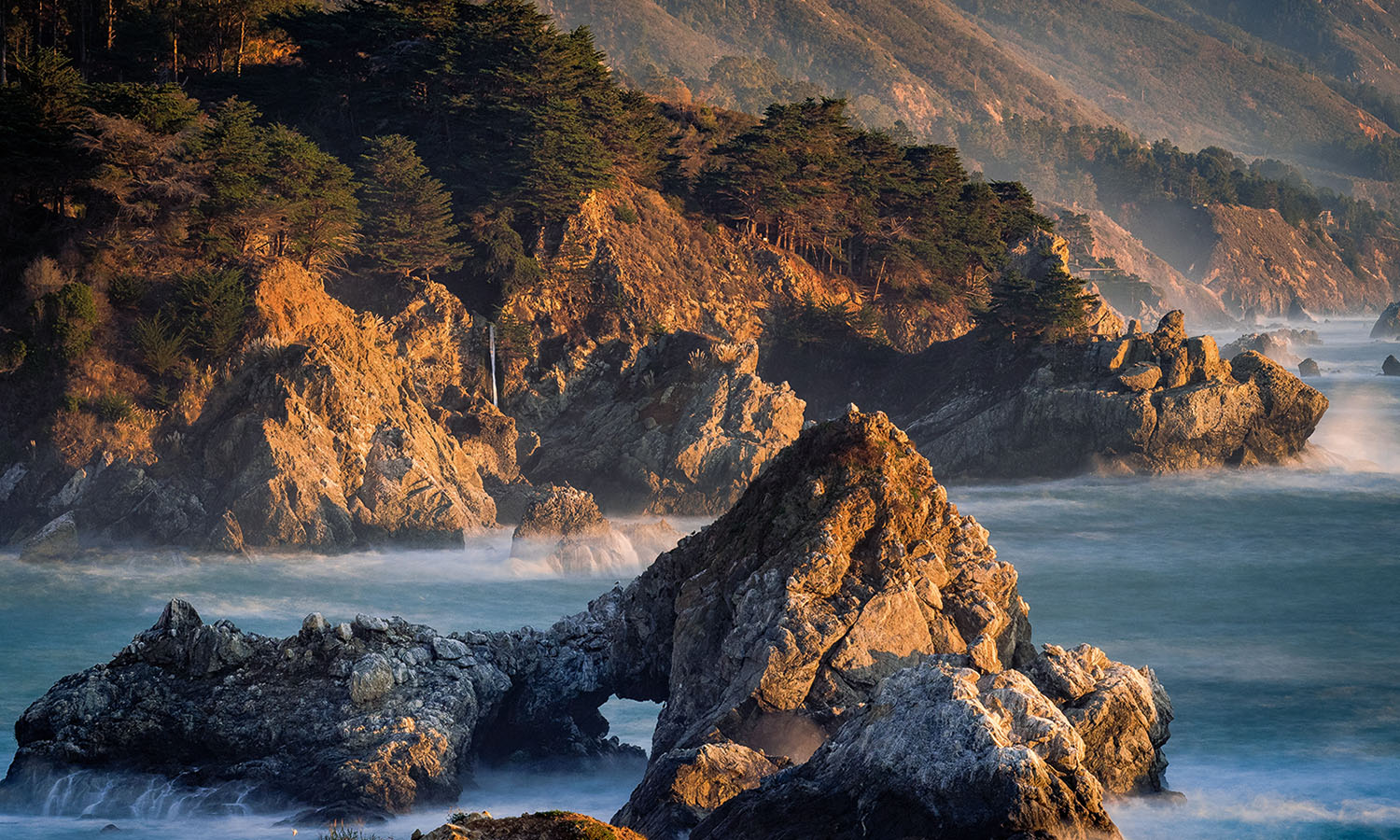

Polarising benefits
Although not a big fan of adding too many extras to my camera, I find a polarising filter can make the magic happen. These filters screw onto the front of your lens and cut out the glare and reflections of the sunlight bouncing off anything shiny. They also add saturation to blue and green tones, making those turquoise waters and juicy green fields look exactly the way you remember them. This essential accessory will make those landscape shots pop.
Rule Of Thirds
There’s nothing wrong with placing the horizon in the middle of the frame, but every time I see a shot like that I feel like I’m missing out on something. Is that straight horizon really what made this location so special? Were there beautiful clouds? Try pointing your camera up a little and place the horizon in the lower third of the frame. Got great texture in front of your feet? Move your lens towards the ground so the horizon is in the upper third of the frame. In either case you’ll immediately capture a much more dynamic shot and the viewer won’t feel like they’re missing out.
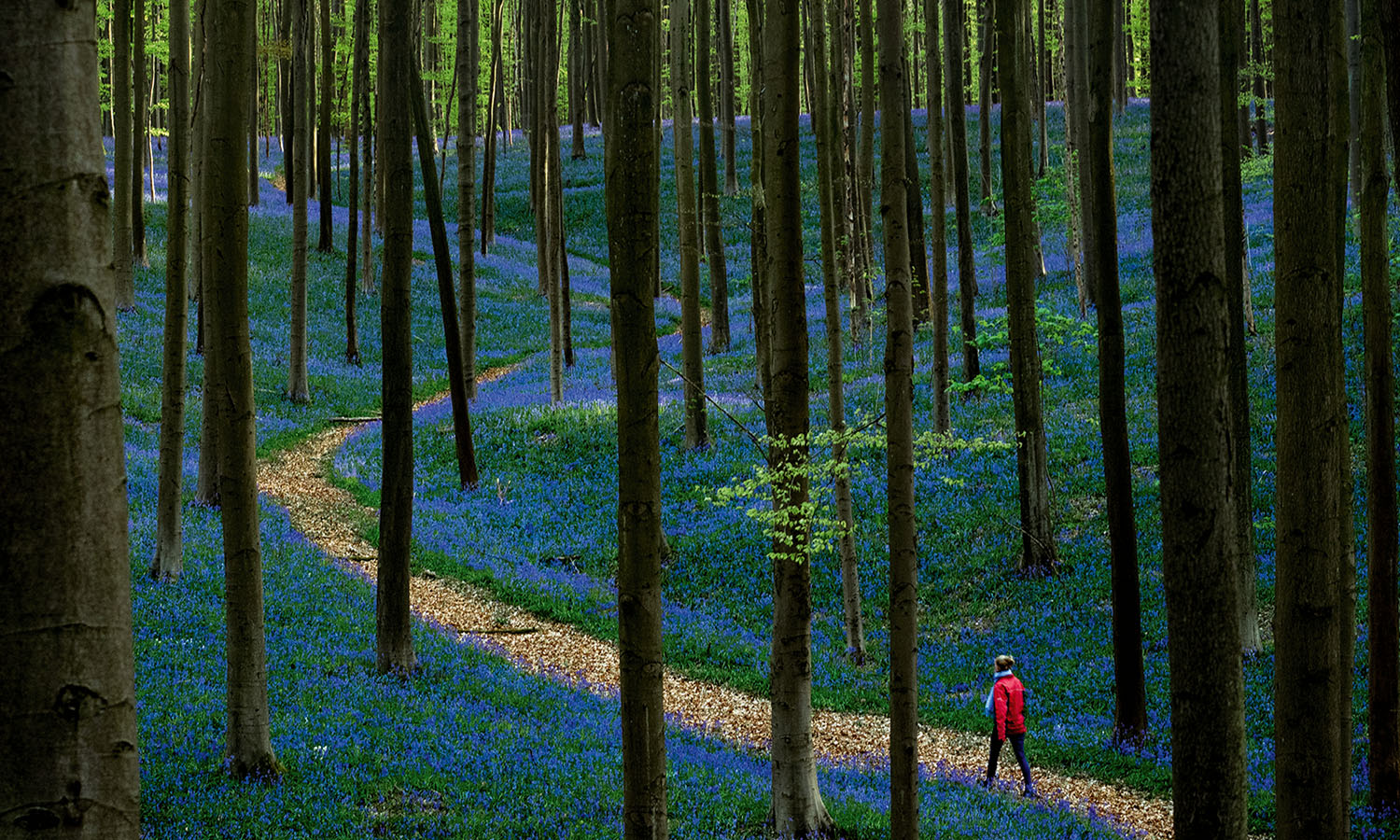

Take A Friend
Remember how I mentioned getting there before the crowds? That doesn’t mean you shouldn’t bring someone along with you. Placing a person into a landscape shot can really emphasise scale, add a focal point and also make the location much more attainable. People see the image and immediately think, That could be me! Bonus tip: bring along a brightly coloured jacket to make the mate you’ve thrown in front of the camera stand out even more.
Be Patient
Once I sat and waited for more than five hours to get the right photo. Why? Because it took me six hours to drive to this location then two hours to scramble down a thorny cliff to the ocean’s edge and I knew I wasn’t going to be returning anytime soon. With a promising sunset on its way I sat and waited, did a few test shots and compositions and waited until I got what I wanted. It paid off. Not only did I get a very unusual shot of a well-known location, but I also had a fun story to tell. Sometimes it’s worth waiting that extra minute for the things to align. It’s not over until it’s over.


Use Your Feet
Go beyond the car park. Anyone can drive to a viewing platform, hop out of the car and take a photo. The person who gets the better images will be the one who leaves their vehicle behind, hikes up a mountain and brings an added layer of story to the shot. It always makes for a more rewarding photograph. And, as always, have fun.
Chris Eyre-Walker is a member of the Olympus Visionary Program, a team of award-winning photographers supported by Olympus.
The Magic of the North
It took one car, two trains and three planes to get to Yellowknife Airport in Canada but, staring at this massive Arctic diorama, the post-travel disorientation had me thinking I had walked into the Museum of Natural History in New York.
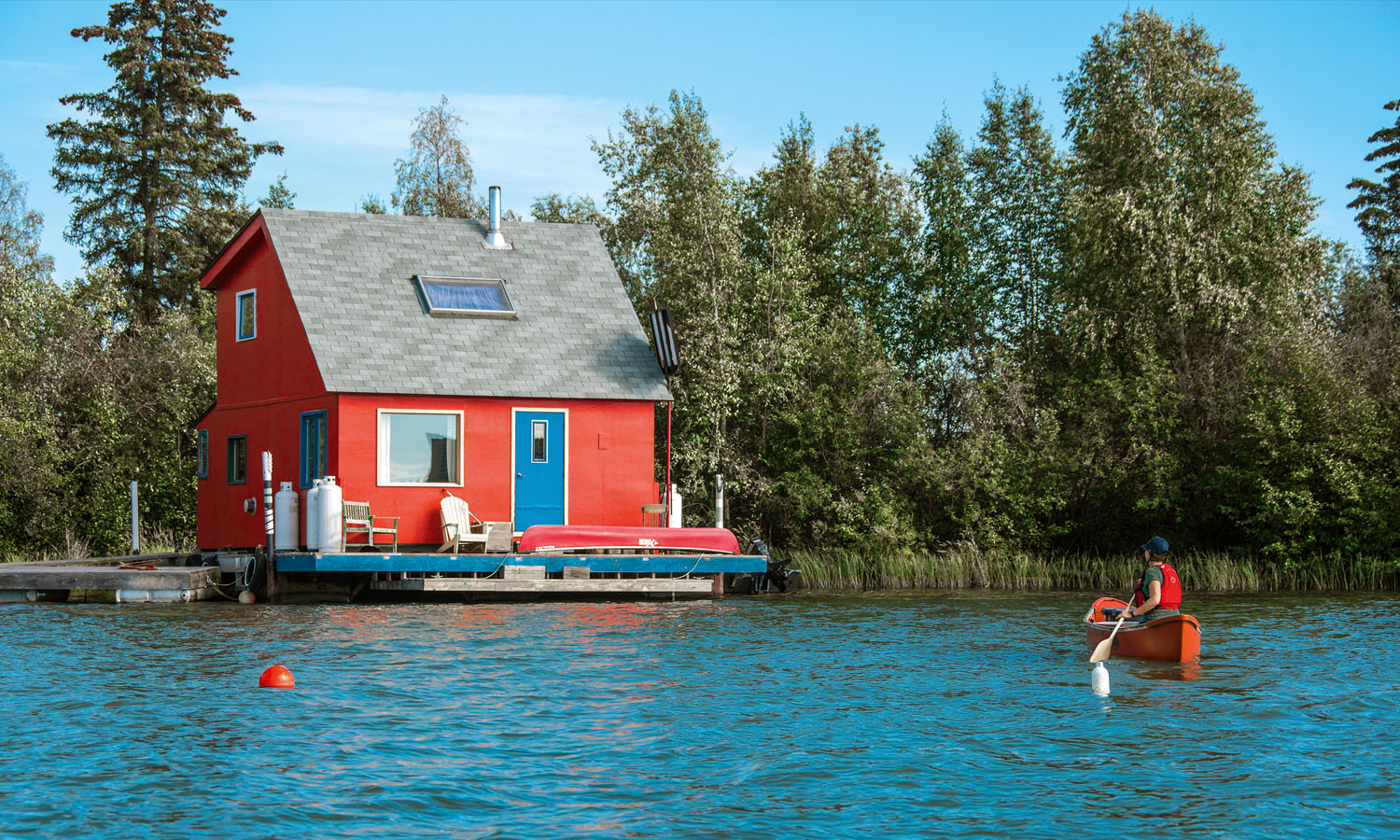

Instead, I am in one of the northernmost towns on the planet in Canada’s Northwest Territories, about to take part in an Arctic photographic adventure with My Backyard Tours. It’s an area so remote they didn’t bother to even give it a specific name – they called it Northwest as if to say, “It’s over there somewhere.” Yellowknife is a true frontier town. It’s full of miners and bush pilots, has a shop that sells sealskin mittens, a saloon full of liquor, tattoos and piercing options, and even a general store that stocks rifles, baby formula and local lore.
No time is wasted introducing our small group of six to the wonder of Yellowknife. Our tour leader and local photographer Robert Berdan takes us on a private tour of historic Old Town and the Prince of Wales Heritage Center, which offers a comprehensive overview of the complex history of the land from the First Nation people to the future of this mining-turned-tourism destination. We are just setting the scene for the spectacular landscapes we are about to explore.
Our boat carves a ribbon through the indigo mirror that is Great Slave Lake, floating past flashy houseboats, each one dazzling with its brightly coloured and flamboyantly artistic uniqueness. We travel north along the Ingraham Trail in search of the majestic Cameron Falls. Robert points out the wildlife and shares tidbits of history, unlocking the secrets of the area as we gaze in amazement at the prolific beauty of this far-flung area.
Well outside the lights of Yellowknife, we stop at a place called Aurora Village. This region has remained somewhat of a secret from tourists despite being one of the best places on the planet to see the aurora borealis. Experiencing this phenomenon here is possible almost year-round, with the clear winter nights of November to April offering the best viewing. The mild temperatures of summer and early autumn, however, make it a tad more comfortable. The village consists of a great dining hall, gift shop and a grouping of mansion-sized teepees that glow bright orange in the darkness thanks to the wood-burning potbelly stoves inside. The scene is set and Robert quickly runs through some pointers to help us get the best shots of the aurora. We turn our heads toward the heavens and wait. When the lights finally take to the stage to perform their five-hour magical dance, we’re all left slack-jawed.
I’ve yet to see a photo that communicates just how otherworldly the phenomenon is. Ribbons of green and purple float across the jet sky, as if a god’s silk scarf has fallen from the heavens and been caught in the celestial breeze. I feel the awe of the people around me, and a strange sense of community forms. It is truly enchanting and one of the only things I’ve come across that offers a childlike belief in magic.
Still high from the previous night’s experience, we are greeted back in Old Town by Chuck Rockwell, a tall, friendly man who is our Air Tindi bush pilot. He’s flying us an hour north to the final destination on this tour, Peterson’s Point Lake Lodge. After a champagne toast we find ourselves skimming across Great Slave Lake in a Twin Otter seaplane. With a quick right bank into the wind, we are on our way.
Below us, lakes dot the surface of the land like a spots of rain on a car bonnet, caribou trails dart in various directions and, from this height, the patchwork of pigmented terrain resembles the colour static on an old television. We spot the cluster of cabins that is our home for the next five nights. Swooping down, the plane gently jostles to a stop atop the sandy lake shore where we are met by the wide smile of Amanda Peterson, owner of this unique nature refuge.
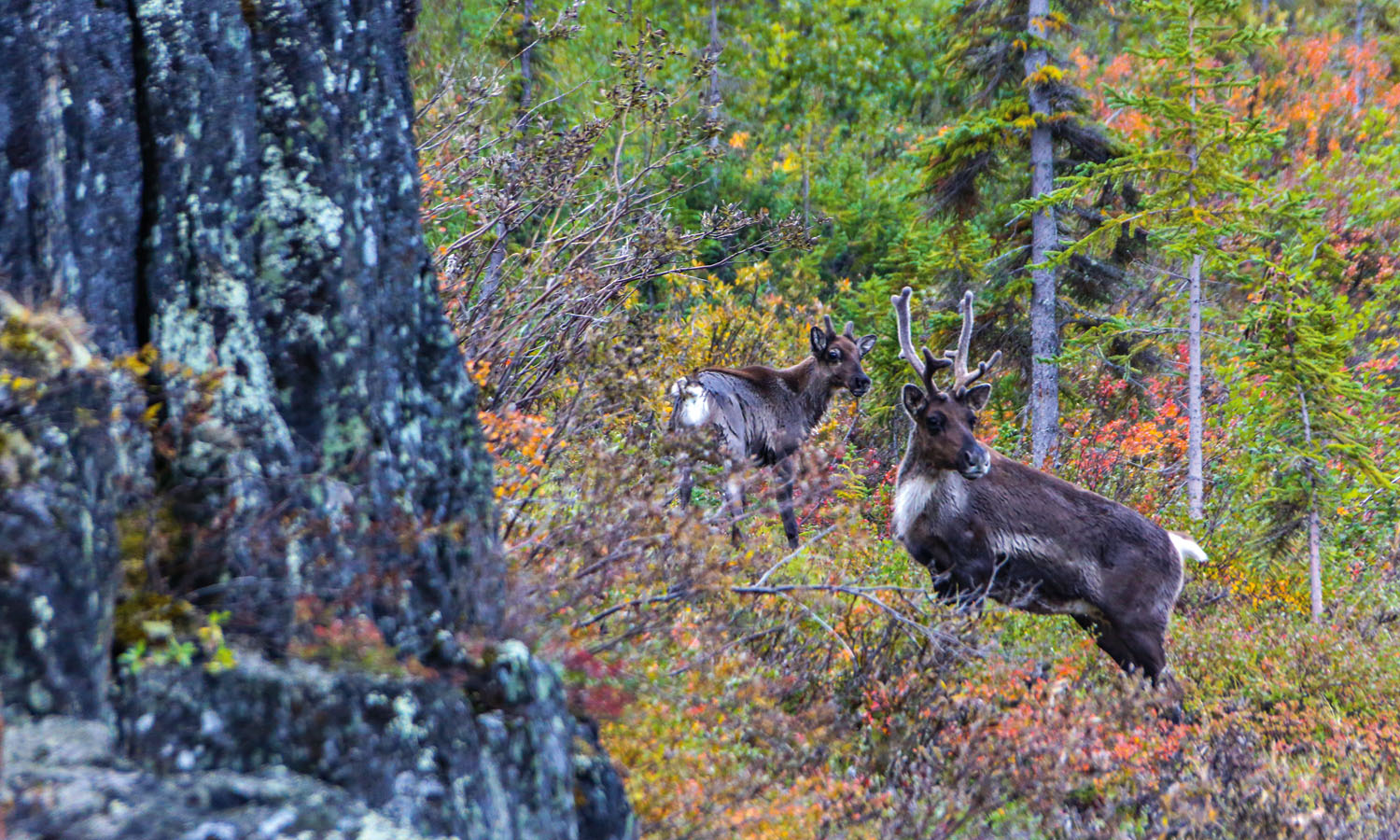



Inside the communal cabin we are greeted with fresh blueberry scones and cranberry muffins pulled from the giant iron stove just minutes before by Norma, the resident chef. We discuss the next five days: hikes through the Arctic expanse, tracking caribou, wolves and bears, world-class fishing, fine home-cooked meals and, of course, more of the aurora. Our guides are as much family as they are employees – they are well-versed outdoors men who have been visiting the lodge since it was simply a summer home Amanda’s father built by hand. Now it is bigger, with multiple cabins featuring diesel stoves, sinks and solar panels – there’s even Wi-Fi. The lodge has a real nostalgic feeling, like being welcomed by long-lost family members. It is paradise of a different kind.
In this land of a thousand lakes, we travel by boat in every possible direction, and our legs carry us through the painter’s palette that is the Arctic tundra. Explosive reds, orange, greens and blues attack our notion of natural in this cartoon land. The few trees here reach barely two metres high, and the shrubs look like manicured bonsai. There are sand dunes, hundreds of metres high and kilometres long, left thousands of years ago by the slowly retreating ice shelf. Mosses and lichens cover every inch of ancient black rock and thick bog pads each step, making it feel as though we’re walking on a giant memory foam mattress.
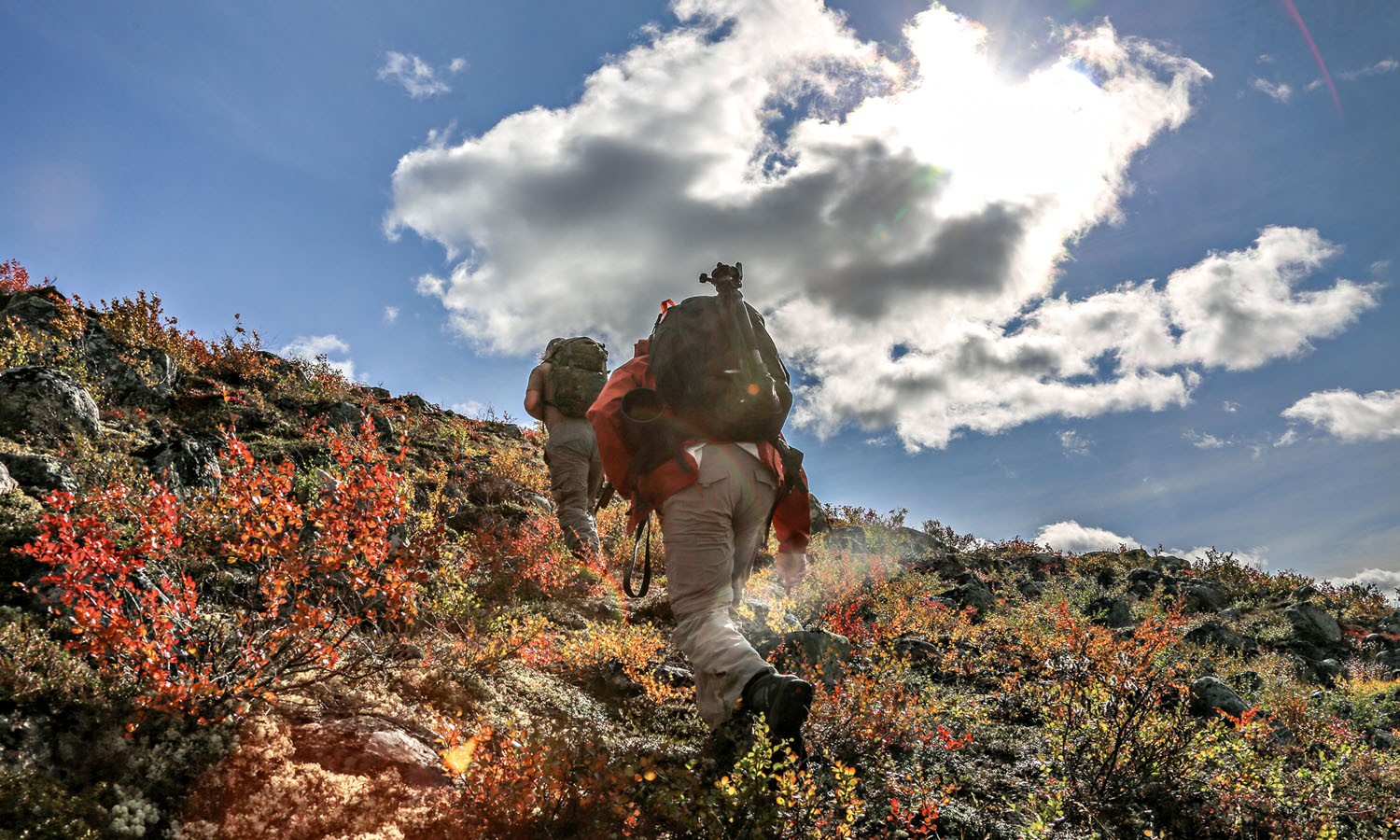

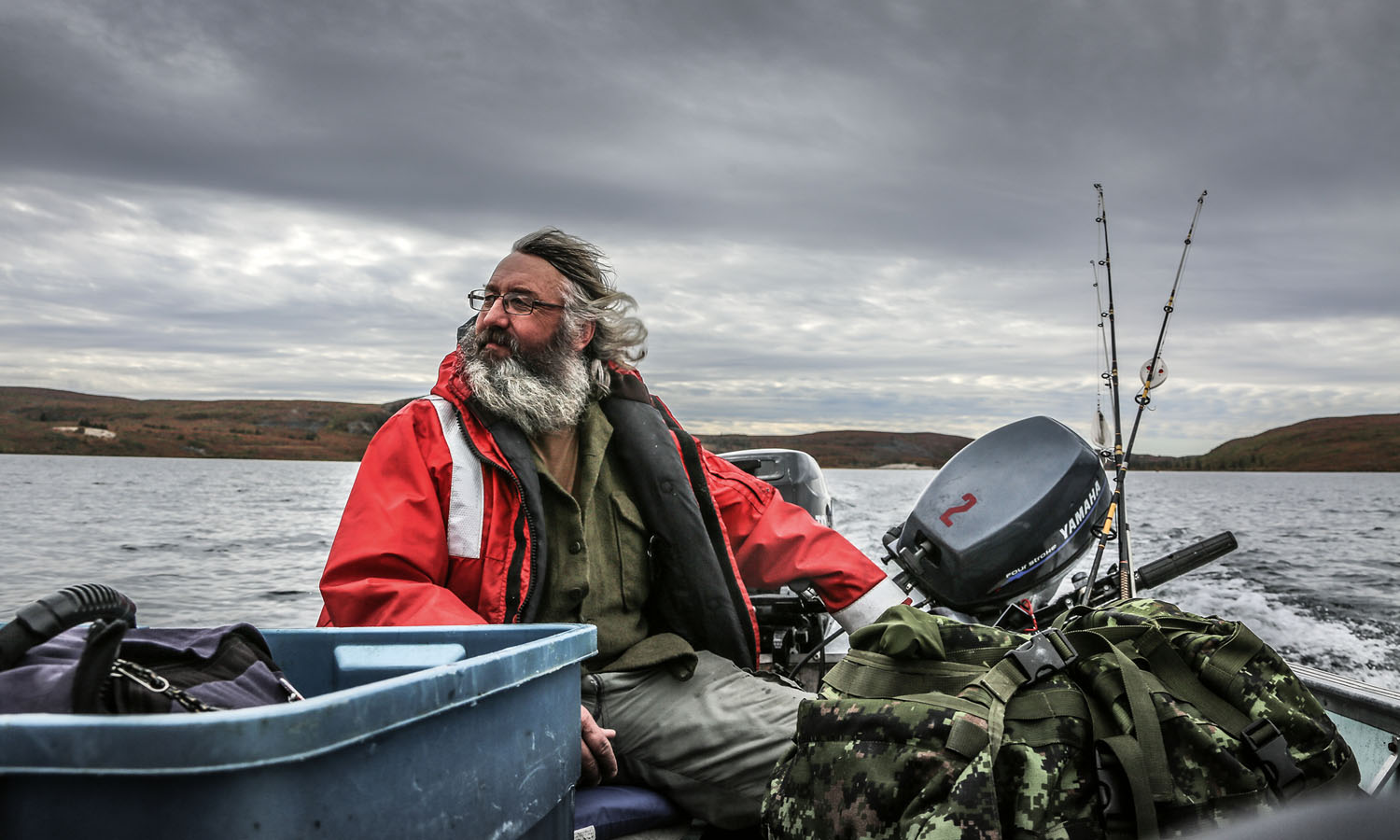

Our guide’s keen eye spots wildlife in the distance. A mother and calf caribou swim swiftly across a great expanse of lake and a lone white wolf ascends a nearby peak looking for its next meal. There are times when our eyes avert to the ground to study mushrooms, and we pick the blueberries, cranberries and crowberries lying low at our feet. With every step, the tundra sprays us with the sweet pine scent of Labrador tea and berry – it’s as if we were walking through the perfume department of the tundra store.
My fishing skills normally extend to hunting for keys in the couch, but here I’m able to easily snag a catch, reeling in several large pike that later become lunch. On a nearby beach, the fish are battered and fried on large cast-iron skillets, then served accompanied by buttered potatoes and fresh salad. There is nothing quite like catching your own meal, except perhaps for a dinner cooked by Norma, who I think is actually Julia Child in disguise. Caribou steaks, chicken florentine, lasagna and an array of delicious meals are served. When night falls our bellies are full and our imagination even fuller from the day’s adventure.
Each night, over cake and hot drinks, Robert gives a brief presentation about photography, covering subjects from composition to processing, preparing us for the next day’s hunt for the perfect image. On the final night, we gather together in the main cabin and relive the magical experience through each other’s eyes. This was more then a typical holiday – it was an otherworldly experience.


The last morning, as we await our seaplane, I gaze over the vast expanse of wilderness. We’ve spent nearly a week exploring and photographing this precious beauty, and yet there is so much more to discover.
That’s the enchantment of Peterson’s Point Lake Lodge and Yellowknife – these are places from which you never fully return. Their beauty is simply too magnetic not to leave a piece of yourself there, waiting for your return.
Uncovering the Americana Music Triangle
Discover the sounds of America on this 10-day personally guided tour uncovering the history of the Americana Music Triangle, cornered by Nashville, Memphis and New Orleans, and lauded as the greatest music destination on the planet. On the Southern Jukebox tour, you’ll visit music venues and recording studios and taste lip-smacking Southern food in this vibrant area that has something for everyone.
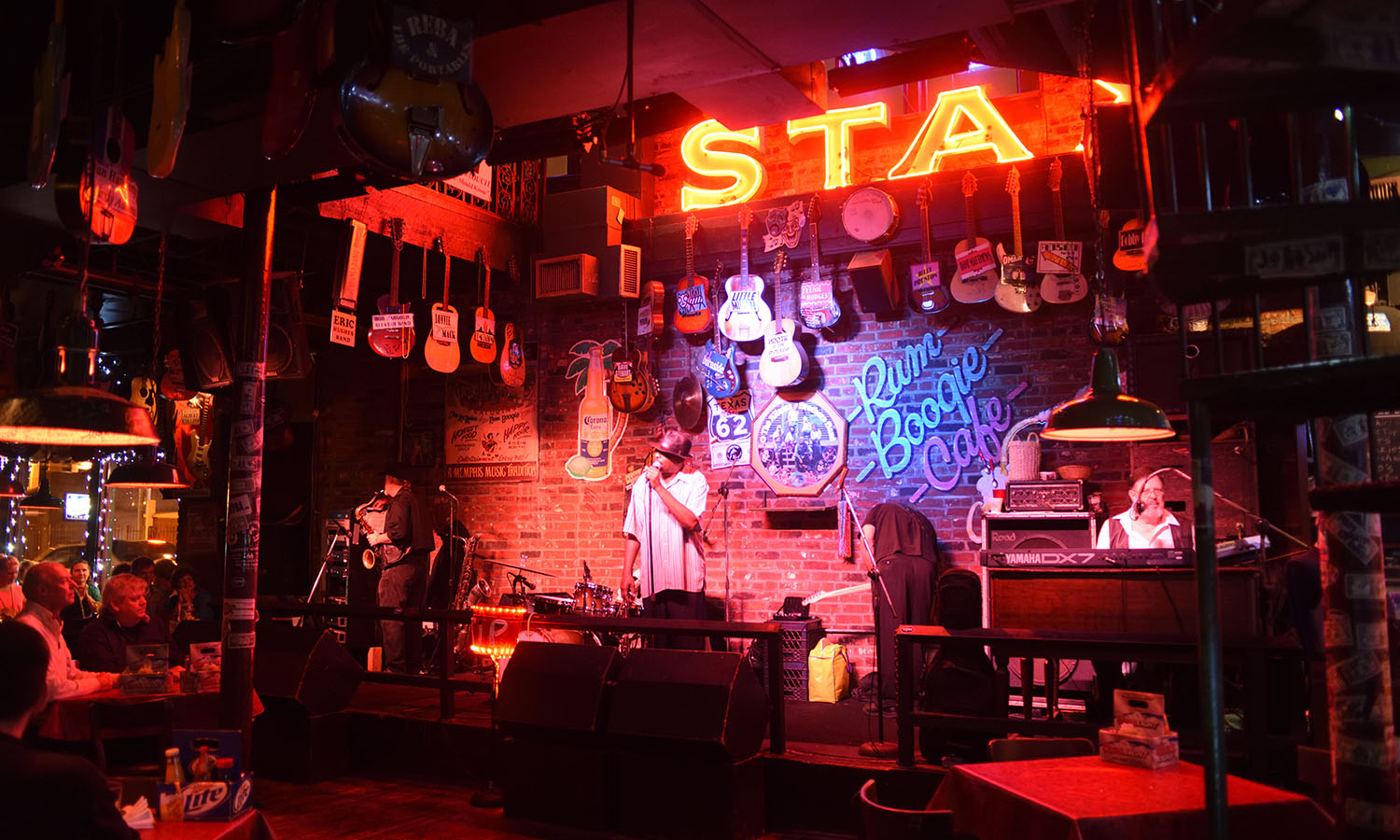

Visit the Country Hall of Fame in Nashville, pop into Hardware where Elvis bought his first guitar and follow it up with a trip to Graceland in Memphis. A dose of the blues and heavenly gospel ballads can be found at one of the many juke joints in Clarksdale. Breathe hot-sauce fire in Louisiana, home of Tabasco, and lose yourself in the sweetness of crooning jazz and tasty beignets in the French Quarter of New Orleans.
Relax with a Sawdust Soak
What could be more relaxing than soaking in a deep bath of sawdust. Wait, what? That’s right, no bulldust here – sawdust is the new bathing buzzword of modern alternative therapies. Immersing yourself in cedar enzymes is an ancient Japanese tradition that boasts a bundle of health benefits.
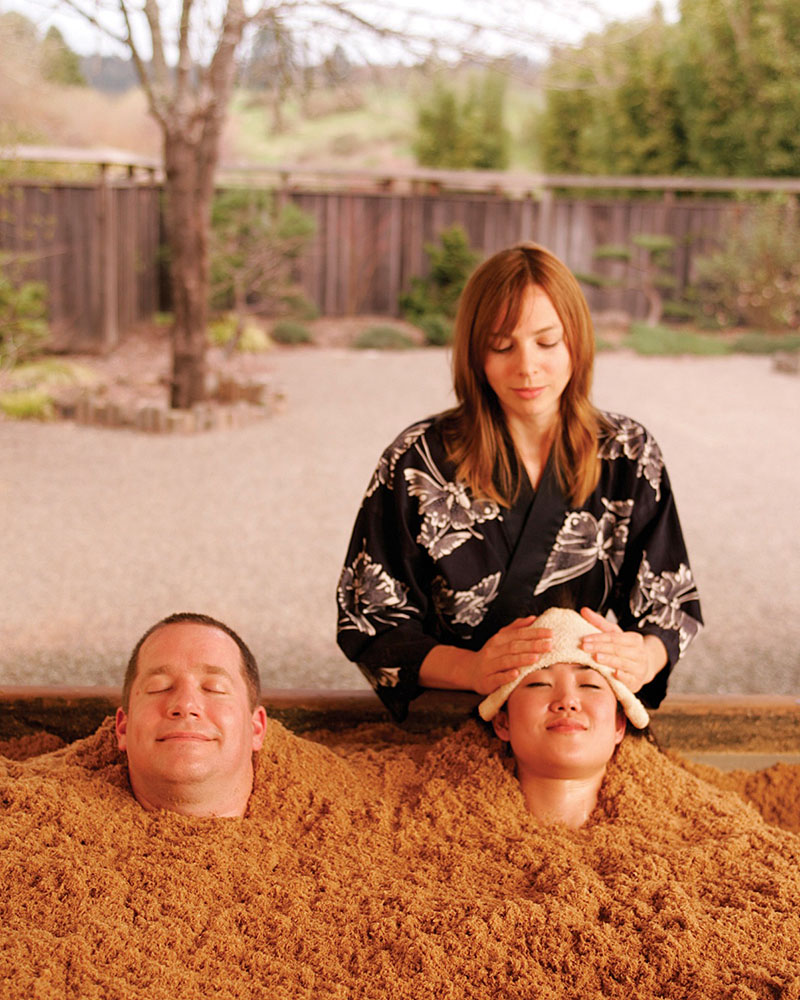

Although taking a bath in fine wood chips sounds like a prickly splinter-fest, when heated, the enzymes from the cypress and cedar trees ferment, creating healing, detoxification properties. Cedar baths are renowned for reducing muscle tension and even boosting the digestive system. Get that chip off your shoulder and give it a go.
 (
(
